Marine Water Heaters Ultimate Guide: All You Need to Know for Efficient Heating Onboard
Marine water heaters are an essential appliance for any boat or recreational vehicle, providing hot water for various uses such as washing up, showering, and even cooking. These heaters are designed to be compact and lightweight, taking into consideration the limited space available onboard vessels. With numerous options available in the market, it can be challenging to choose the right marine water heater for your specific needs.
In this ultimate guide on marine water heaters, we will explore the different types of heaters available, their features, and the key factors to consider when making a purchase. By the time you finish reading, you will have a good understanding of marine water heaters and be better equipped to make an informed decision on which model is best suited for your boat or RV.


Types of Marine Water Heaters
Marine water heaters are an essential part of any boating experience, as they provide hot water for various purposes, such as cooking, bathing, and cleaning. There are three primary types of marine water heaters available on the market: electric water heaters, engine-connected heaters, and hydronic heaters. Each type offers different benefits and suits specific needs, depending on the boat's size and power capabilities.
Electric Water Heaters
Electric marine water heaters rely on an electric heating element to heat the water. These units are typically connected to the boat's electrical system, either 120V AC or 12V DC, depending on the model. They provide a reliable source of hot water with minimal maintenance requirements. Some popular electric marine water heaters include the Whale 6-gallon Premium Water Heater and the Kuuma 6G 120V Rear Heat Exchange . Electric water heaters are ideal for boats with a stable electrical supply.
Engine-Connected Heaters
Engine-connected marine water heaters use the heat generated by the boat's engine to heat the water. These heaters often feature a double-walled heat exchanger system that transfers heat from the engine's cooling system to the water tank. A popular example of this type of heater is the Whale Marine Water Heater - Premium . Engine-connected heaters are a highly efficient option for boat owners who frequently operate their engines, as they make use of the engine's waste heat.
Hydronic Heaters
Hydronic marine water heaters use a closed-loop system that circulates heated water or coolant throughout the boat's interior. These systems often have multiple heating zones, with individual temperature controls for each area of the boat. Popular manufacturers, like Webasto , offer a range of models to suit different boat sizes and heating requirements. Hydronic heaters tend to be more fuel-efficient than electric heaters, as they use a smaller amount of energy to maintain the desired temperature. They are suitable for boaters who prioritize fuel efficiency and have the necessary space to install the heater and its required components.

Key Features to Consider
The capacity of a marine water heater is an important factor to consider, as it determines the amount of hot water available for use on your boat. Capacities typically range from 6 to 20 gallons, so choosing the right size depends on your boat's requirements and the number of people on board. A smaller capacity may be sufficient for smaller boats or short trips, while larger capacities are more suitable for bigger boats or extended trips.
Power Source
Marine water heaters can be powered by a variety of sources, including electricity, engine heat, and propane. Electric marine water heaters, like the Kuuma 6G 120V , rely on an immersed heating element to warm up water, while engine-powered heaters connect to the boat's engine to utilize its heat. Propane heaters, on the other hand, use a propane burner to heat the water. Each type of power source has its own advantages and drawbacks, so choose one that best suits your boat's setup and your specific needs.
Materials and Construction
The materials used in the construction of a marine water heater can also impact its long-term durability and performance. Many marine water heaters feature stainless steel or galvanized steel tanks, as these materials are known for their corrosion resistance and longevity. For example, the Whale F600 Water Heater has a galvanized steel tank, while the Kuuma 11G 120V is made of stainless steel. It's important to select a water heater made from high-quality materials that can withstand harsh marine environments.
Safety Features
As with any appliance, safety is a crucial consideration when choosing a marine water heater. Look for water heaters with built-in safety features, such as overheat protection, pressure relief valves, and ignition protection. These features can help prevent malfunctions and potential accidents while onboard your boat.
Ease of Installation
Lastly, consider how easy it is to install a marine water heater on your boat. Some heaters, like the Kuuma 6G 120V side mount front exchanger , offer more flexible installation options, making them suitable for tight spaces or corners. Others may have more specific requirements for placement, which can be a challenge in limited spaces. Ensure that the water heater you choose can be easily installed on your boat without requiring significant modifications.

Popular Marine Water Heater Brands
Several well-known brands in the marine industry offer high-quality water heaters suitable for various types of boats. In this section, we will discuss a few popular marine water heater brands to consider for your boating needs.
Kuuma: Kuuma is a trusted name in marine water heaters, offering reliable products designed for marine applications. Their 6G 120V Side Mount Front Exchanger and 11G 120V Front Exchanger SS are popular models known for their durability and performance. Kuuma water heaters come in various sizes and configurations, making it easy to find the right one for your specific needs.
Whale: Whale is another renowned brand in marine water heaters. They produce durable and efficient heaters suitable for boating enthusiasts. The Whale F600 Water Heater , with a 6-gallon capacity and front heat exchanger, is one of their popular models. Whale water heaters are also available in various sizes and configurations to meet diverse boating requirements.
Raritan: Raritan Engineering is known for its high-quality marine water heaters designed to perform in harsh environments. Their 1700 series is engineered specifically for marine applications and offers reliable performance with dockside recovery rates of up to 18 gallons per hour. The adjustable thermostat in Raritan water heaters enables precise temperature control, making them an excellent choice for boaters.
In conclusion, Kuuma, Whale, and Raritan are some of the popular marine water heater brands to consider when upgrading or installing a new system on your boat. Each brand offers a range of products tailored to suit various needs, ensuring that you can find the right water heater for your specific situation. Keep in mind that researching and comparing different options is vital to making an informed decision and getting the most value for your investment.

Maintenance and Troubleshooting
Regular maintenance.
Proper maintenance is crucial to ensure the longevity and efficiency of marine water heaters. Regularly inspecting the water heater and its components can prevent potential issues and costly repairs. Some essential maintenance tasks include:
- Checking and replacing the water heater anode when necessary. The anode protects the tank from corrosion, and wrapping Teflon tape around the threads of the anode can help prevent leaks during reinstallation ( BoatUS ).
- Examining pipe joints and hose connections for leaks. Using Teflon tape or pipe joint compound can help prevent dripping, and hose clamps ensure tight seals on hose barb-to-hose connections ( Practical Sailor ).
- Ensuring proper and consistent supply of gas and electricity to the water heater. Test for stable gas supply by lighting a stovetop burner, and use a voltage meter to check that input to the heater is at least 10.5 volts ( RV Repair Club ).
Common Issues and Solutions
Marine water heaters may experience various problems, which can often be resolved with some basic troubleshooting:
| Issue | Solution |
|---|---|
| Insufficient hot water | Check the thermostat setting and adjust if necessary. Also, inspect for potential leaks in the plumbing system or faulty heating elements. |
| No hot water at all | Verify that the water heater has proper gas and electrical supply. Ensure that the heating element is functioning correctly and that the thermostat is set at the desired temperature. |
| Leaks | Inspect pipe joints, hose connections, and the water heater tank for any signs of leakage. If a leak is found, applying Teflon tape or pipe joint compound and tightening connections can help resolve the issue. |
| Corrosion | Regularly check and replace the water heater anode to protect the tank from corrosion. Use Teflon tape around the threads of the anode to prevent leaks during reinstallation. |
Consulting the water heater's manual and seeking professional assistance when unsure about diagnosing or resolving an issue is recommended. Regular maintenance and diligent troubleshooting can help extend the life and enhance the performance of marine water heaters.

Environmental Considerations
When selecting a marine water heater, it is essential to consider the environmental factors that will impact its performance and longevity. Marine environments expose water heaters to high-humidity, aggressive water conditions, and other harsh factors that can affect their functionality and reliability.
One major concern in a marine environment is corrosion. It is crucial to choose water heaters that have corrosion-resistant components to ensure long-lasting performance. Many top-quality marine water heaters, such as those offered by Torrid , include glass-lined inner tank vessels to mitigate the risk of corrosion and reduce bacterial buildup.
Eco-friendly operation is another important environmental consideration. Look for water heaters that meet stringent energy efficiency standards and provide optimal heat transfer without excessive energy consumption. Additionally, these heaters should have minimal noise output to limit noise pollution in the surrounding marine environment.
Furthermore, insulation plays a crucial role in maintaining the water temperature and reducing heat loss. Marine water heaters with good insulation, like the polyurethane foam used in Sigmar heaters , can still have water heated at more than 80-degrees after 20 hours of shutting off the heating element.
Last but not least, proper installation is key in minimizing potential environmental risks. Ensuring that the water heater has a secure mount on a well-reinforced surface can help prevent potential damage and instability during rough seas, as mentioned by Practical Sailor .
Considering these environmental factors will help guide boat owners in choosing a suitable marine water heater that is reliable, efficient, and durable in the challenging marine environment.

In this ultimate guide , we have discussed various aspects of marine water heaters, from the top-rated models to the factors that should be considered when making a purchase. The 5 best marine water heaters we reviewed, such as Whale Premium Water Heaters and Kuuma Water Heaters, showcase the options available to boat owners.
When investing in a marine water heater, factors like size, capacity, heat exchanger type, and power source are crucial in making the right choice. For instance, smaller boats may benefit from a compact design like the Cobalt Aquatics Neo-Therm , while larger vessels may need heaters with greater capacity.
An efficient marine water heater not only provides comfort but ensures a pleasant and warm experience during long sailing expeditions. Since various models are available on the market, carefully weighing your specific needs and preferences will lead to a suitable purchase that will cater to your boat's heating requirements.
Lastly, proper installation and maintenance of your marine water heater are key to reliability and longevity. Make sure to follow the manufacturer's guidelines and consult professionals when necessary. By taking all these factors into account, you can select and maintain the ideal marine water heater tailored to your unique needs.
Related Articles
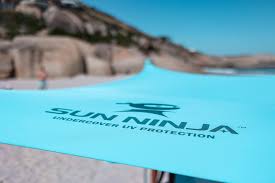
Sun Ninja Beach Tent: Ultimate Protection and Convenience for Beachgoers
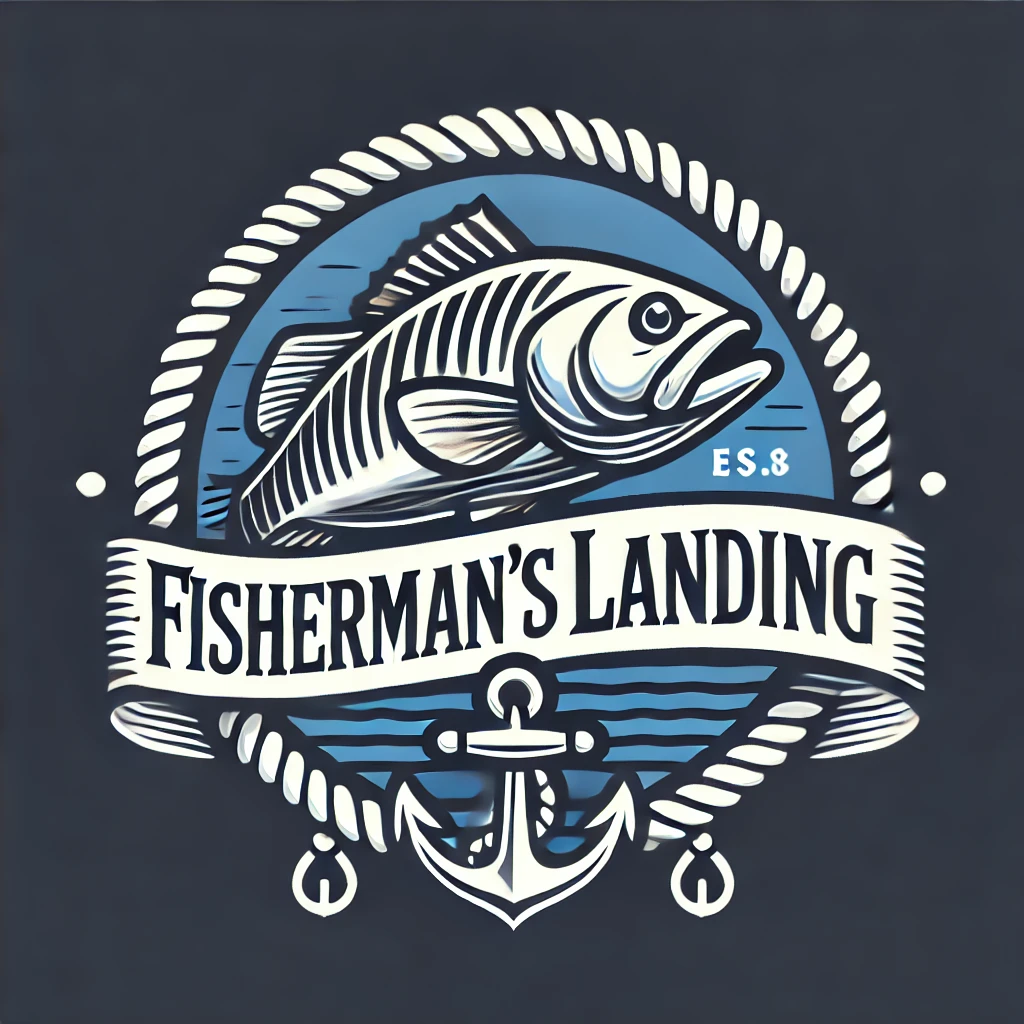
Fisherman's Landing: Your Ultimate Guide to Coastal Fishing Spots
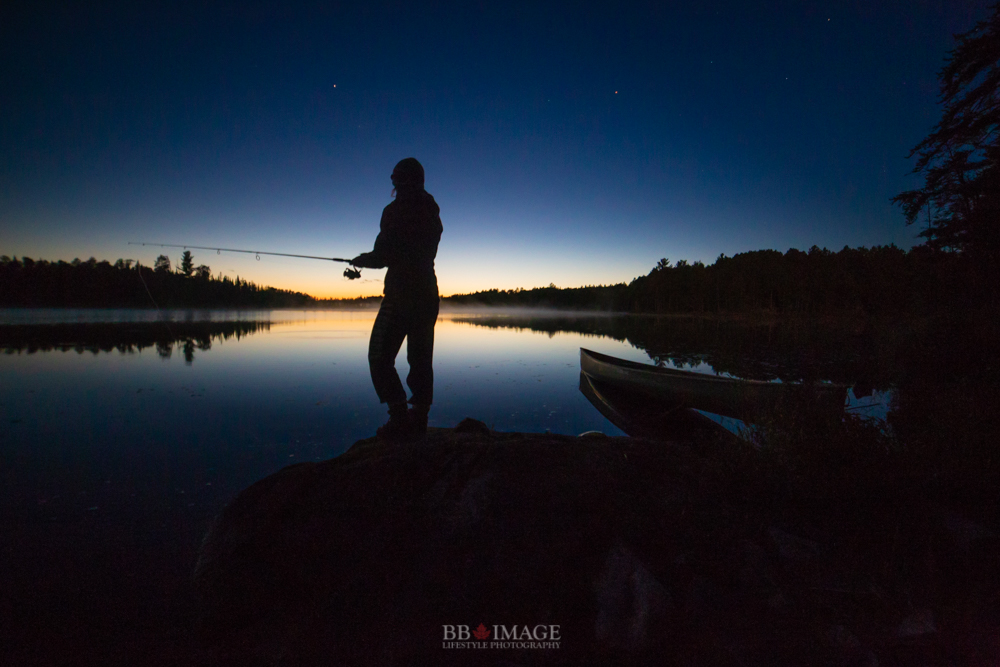
Night Fishing: The Ultimate Guide to Mastering the Art of Nocturnal Angling

50 Best Boat Names of 2023: A Wave of Creativity and Wit

What Should You Do After Your Boat Runs Aground and You Determine There Are No Leaks? Steps for Safe Recovery

Pavati Wake Boat: The Ultimate Choice for Watersports Enthusiasts
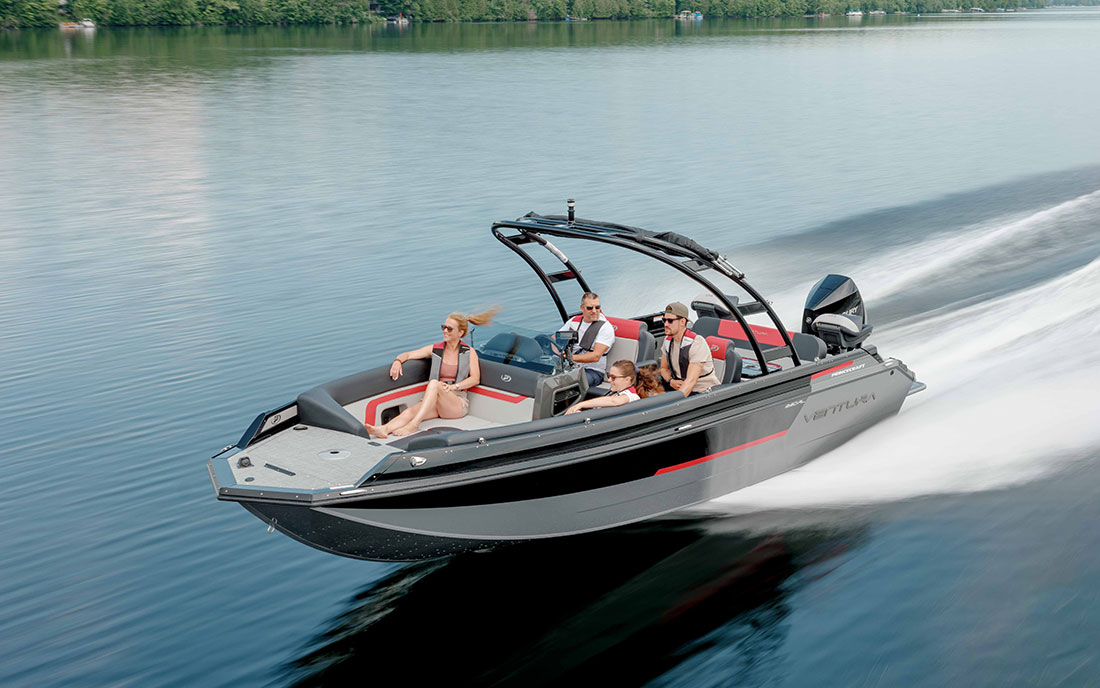
Deck Boats 2024: Top Models and Innovations to Watch

Hydrafoil for Boats: Comprehensive Guide to This Maritime Innovation

Boating Basics Online is reader-supported. When you buy via our links, we may earn a commission at no cost to you. Learn more
The Best Marine Water Heaters for Your Boat or RV
Written by J. Harvey / Fact checked by S. Numbers
A boat is a pricey investment just like your house. Therefore, it’s natural that you give it the same amount of attention. Equivalent to furnishing your house is getting the right and quality accessories for your boat, of which includes the best marine water heater.
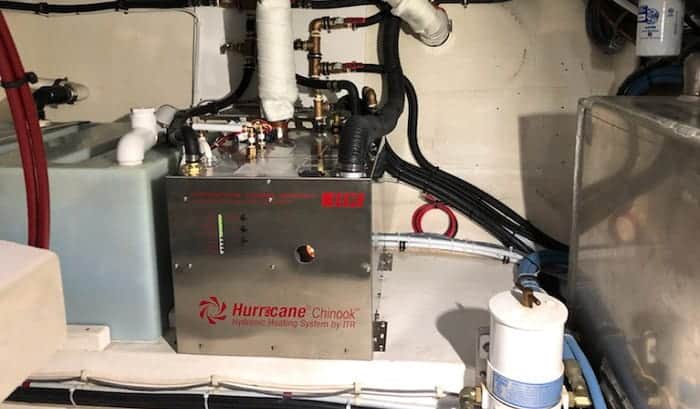
Warm or hot water is essential when sailing as you utilize it for showering and washing up. Just make sure that you get the right heater size so that you can optimize the usage and performance. Unlike residential heaters, marine water heaters don’t consume a lot of energy.
There are numerous marine hot water heaters that you can find. You can avoid confusion by reading this comprehensive review so you’ll be oriented with the important features. Consequently, you can select the most suitable for your boat.
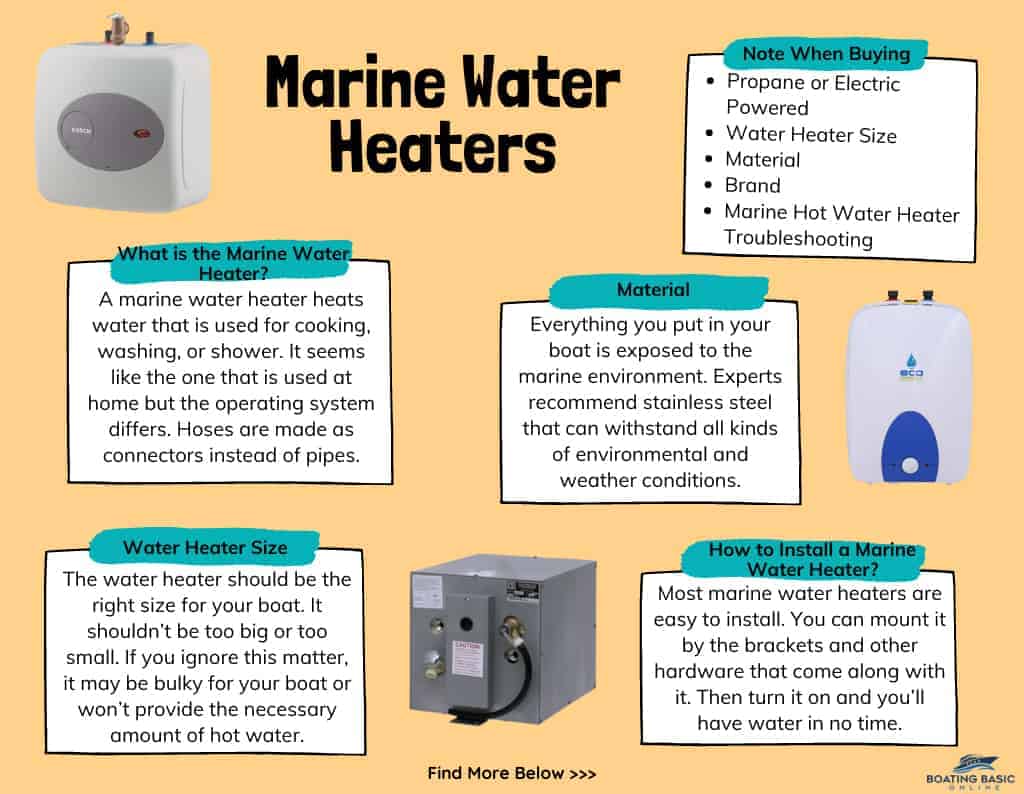
- Works with solar power
- Provides hot water in 5 minutes
- Easy installation
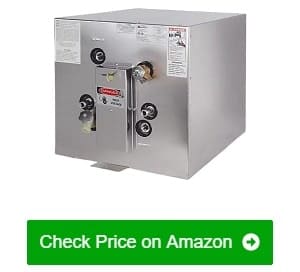
- Doubles the supply of hot water
- Has good-quality parts
- High-quality construction
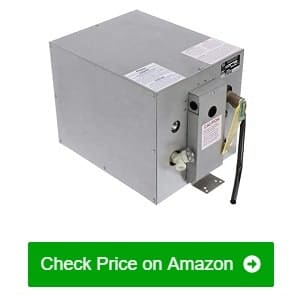
- Durable
- Has 2-year warranty
Table of Contents
1. Whale Premium Water Heater
2. kuuma 11g 120v front exchanger, 3. whale premium water heater capacity, 4. kuuma water heater rear heat exchanger, 5. bosch 7738004996 electric water heater, 6. ecosmart eco mini electric heater, 7. kuuma 120v 6 gallon water heater, 8. whale f700 water heater, 9. bosch es8 tronic 3000 t water heater, 10. whale 68954 seaward hot water heater, 11. suburban 52747a water heater, 12. whale seaward zxc-f600wcwe water heater, factors to consider when choosing marine water heaters, what is the marine water heater, who makes the best marine water heater, how to install a marine water heater, which water heater is better rheem or ao smith, best marine water heater reviews.
You’ll find this product from Whale which is a part of Attwood in several marine water heater reviews due to its dependability. It’s an efficient hot water supplier in my sailboat. I sometimes use solar power to make it work.
When it’s time to take a shower, I only need to wait for 5 minutes to get warm water. That’s why I call it an instant heater! Aside from quickly turning water hot, it can supply you with plenty of it. To prevent water from becoming scalding hot, I added an automatic thermostatic mixing valve to the outlet.
The installation is easy as I mounted it horizontally. It’s like doing plug and play as everything is a match. No tiresome process is required before reaping benefits from this 6-gallon heater that only requires 120V. It’s a relatively compact water heater. Thus, you don’t need a lot of space for it.
- Produces plenty of water supply
- Easy installation or horizontal mounting
- Compact so it take up a lot of space
- Durable because of its premium components
- Adding automatic thermostatic mixing valve to the outlet so that water won’t be scalding hot
Due to this quick marine water heater, the supply of hot water in my boat doubled. It’s lightweight with fiberglass sheets for insulation. This design allows me to remove the case to minimize the space that it occupies.
I was happy that I am able to connect it to the freshwater cooling system of the boat’s engine. Water heating can be done with 110V AC when the engine is not running. However, it’s recommended to fill and cap the pipe with antifreeze when you let it run with AC.
You’ll find black, white, and green wires that have good quality. If you have the same wires in your boat, it’s easy to connect them. Installation is manageable in my case. I figured out what to do after I saw the parts. It has a nice recirculation system that works in producing hot and cold water.
- Lightweight and space saver by removing the case
- Can be connected to the freshwater cooling system of the boat’s engine
- Has good quality parts
- Has a recirculation system for hot and cold water
- Durable due to its high-quality construction
- Needs antifreeze in the pipes when connected to 110V AC
With the 11 gallon capacity of this water heater, I have enough hot water onboard whenever I need it. I think that Whale is a part of Attwood company as the two-year warranty card is addressed to the latter.
It’s a great replacement for my previous heater even though it’s a tad bit larger. Luckily, the plates can be flattened against the case to make some room. This results in decreasing the depth. Although it’s another task, installation is fairly easy. Screwing down plates and horizontal mounting is not that difficult.
Operating this heater starts with 120 volts or 220 volts. It’s flexible when connecting to power sources as it has extra ports. Thus, there are options for you to plug it into the engine coolant or run off the heat engine. The second alternative works even though the boat is underway and it functions without the help of a generator.
- Provide enough supply of hot water onboard
- Fairly easy installation
- Has extra ports for different power sources
- Durable due to rugged construction
- Ignition is protection to prevent harm and accident
- Has plates that may be a tad bit larger than the designated place
- Water turns hot after 45 minutes
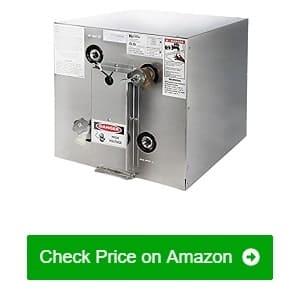
Since the exterior shell of this is composed of marine-grade aluminum, it can last for several years. As I’ve used it for a year with no issues, it’s much better than the other one. I didn’t have to make adjustments as its measurement is similar to my previous water heater.
This has a 6-gallon capacity that never fails to provide the necessary amount of hot water. Thanks to its large diameter and 1,500W heating element! There are other features that I like about it. A high-temperature limiter is present and it has an automatic reset. Also, the circuitry is ignition protected for safe operation.
The heat exchange barbs are found at the back while the fittings and connections are in the front. Installation is relatively easy so I didn’t have to spend a lot of time when going through all the steps. This heater can start working through AC power or engine heat when your vessel is underway.
- Composed of marine-grade aluminum to last for several years
- Provides enough hot water due to 1,500W heating element
- With temperature limiter and automatic reset feature
- The circuitry is ignition protected for safety
- Relatively easy installation
- Works with AC power and engine heat
- Capping off the heat exchanger with anti-freeze so it can supply the needed amount of hot water
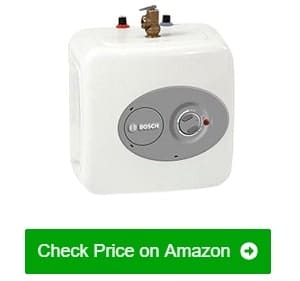
Although this is a mini-tank water heater, it has a number of great features. First and foremost, it’s capable of giving off instant hot water as it can maintain the high temperature. It fascinates me because I don’t need to wait for even a single minute. The warmth is good enough for my outdoor showers. I also use it when washing dishes.
It stands out when it comes to the quantity of hot water. Five to seven gallons can be obtained at 98 degrees Fahrenheit.
Be aware that it may be too hot at first and may likely be so for the first gallon. Despite this minor drawback, it can serve two sinks without compromising performance. Also, the recovery rate is fast. With these abilities, I can say that it’s perfect for heating water from distant faucets.
Since this is tankless, the mounting options are not limited. You may place it on the wall, shelf, or floor. In any way you do it, it will always be easy because of its size. The same reason helps me avoid wasting water as I only get what I need. Just like any other RV marine electric tankless water heater, this saves energy as you only heat the water when necessary.
- Gives hot water in an instant even for two faucets at the same time
- Can provide five to seven gallons of hot water
- With a fast recovery rate
- Mounting options are not a limited and easy installation
- Separate warranties for the unit and the parts
- Makes you save water and energy
- The first gallon of water may be too hot
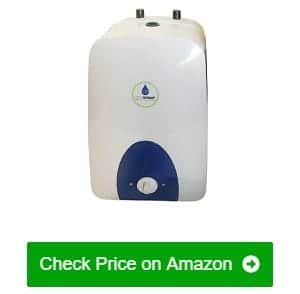
I read some marine hot water heater reviews which convinced me to buy this item. The efficacy of this equipment is not only for household use but onboard as well. Eventually, I wasn’t disappointed. I only need to count seconds to have hot water. Moreover, the performance remains incredible even with a distant faucet.
When onboard, I need hot water to complete menial tasks and quick washing. As such, this heater is a reliable companion. Even my boat bidet with a sprayer became functional because enough supply of warm water came out of it. What’s even better is that this mini tank can give you both hot and warm water.
I like that it’s compact and lightweight with a sleek design and a temperature display. The size of this tank reminds me of a toaster oven. It has pretty good insulation so no energy is wasted. Plug it into a 110-volt outlet and it will start working.
- Heats water in a matter of seconds
- Works on a distant faucet
- Gives water instantly so perfect for quick washing and simple tasks
- Can provide both hot and warm water
- Compact and lightweight with a sleek design and a temperature display
- Has good insulation to not waste energy
- Need to add couplers and tape to secure the connection
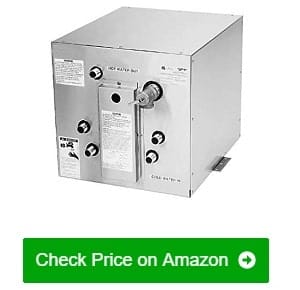
Water heaters made by Kuuma are known for their durability. They are made of aluminum to ensure that you can use them for many years. So, I didn’t think too hard before buying this one. My hunch was right as it turned out to be the perfect replacement for the previous heater in my 1985 O’Day 28 sailboat. I’m enthralled by how it perfectly fits into the cockpit locker due to its side mount feature.
Hot water when cruising the vast sea can be both a necessity and a luxury. Thus, I was prompted to get this heater with great abilities. There are two ways to heat water due to its dual-loop feature. It can be done through the boat’s engine and shore power. When the vessel is underway, you can connect it to AC power. You may even use raw power heating.
It also promotes safe operation, especially for gasoline-powered boats. The credit goes to the circuitry that is ignition protected. There’s a limit to high temperatures and an automatic reset. Hence, you won’t be surprised with scalding hot water. Quick recovery is another wonderful ability from its 1,500W heating element.
- Durable and lasts for many years
- Suits old model vessels
- Works with different power sources
- Promotes safety operation
- Quick recovery of hot water
- Uncomplicated installation
- Separately buying the necessary hardware
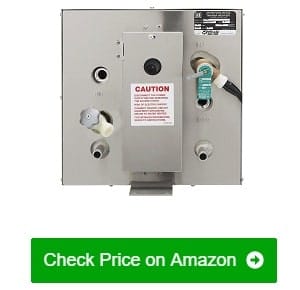
The need to have a huge supply of hot water made me buy this product. You can get 6 gallons or 23 liters from it. It has a thermostat that regulates the electric heating element while it can also produce cold water if you need it.
When heating water, it can reach a temperature of 140 degrees Fahrenheit. But with the temperature-pressure relief valve, the water can’t get too hot. A bilge pump is also added to stop electricity sparks. Since it can dispense both hot and cold water, its design includes waste management.
You can rely on its durability as the inner tank is composed of aluminum and the exterior is of marine-grade stainless steel. These materials guarantee long-term service and strength to face the rigors of the marine environment. That’s why the manufacturer has the confidence to give a two-year warranty to all users.
The double-walled construction is also great as it protects the freshwater supply from contamination. Thus, I don’t worry too much about the water that I keep in my boat.
It’s convenient to just focus on the same area when working on the tank since the fittings and heat exchanger barbs are all situated in the front. Therefore, both the installation and marine hot water heater troubleshooting are easy. Hold-down brackets complete the horizontal mounting of this heater and it’s done with no troubles.
- Contains a huge supply of hot or cold water
- Has parts for safe operation, waste management, and prevention of contamination
- Durable for long-term service
- Has a two-year warranty
- Easy installation and troubleshooting
- Hot water retention for 10 hours
- Very first water release is too hot
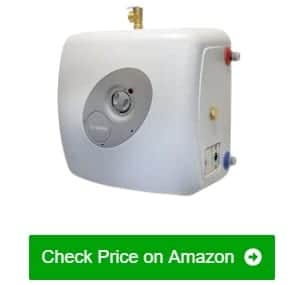
I like this product very much as it’s an effective marine tankless water heater. In just 35 minutes, the entire tank of 7 gallons is filled with hot water! Using it gives me so much ease and convenience. I don’t have to turn it on again and again as the water stays hot.
Installation is super easy since it’s substantially hardwired. I think everyone can do it with no difficulty at all. It can also produce cold water. You may mount it horizontally and vertically. But make sure to prepare enough space for it as it’s not exactly mini. Still, you have the freedom to put it on the wall or the floor.
I mounted it with PEX and once it’s done, hot water came out in just 9 seconds. Thus, it’s right to say that it heats up quickly. The temperature that it handles ranges from 65 to 145 degrees Fahrenheit. I can customize the temperature of hot water as there’s a thermostat swing.
- Can make 7 gallons of hot water
- Easy and convenient to use
- Super easy installation
- Heats up quickly and fast
- With a thermostat swing to customize the temperature
- Energy-efficient even though the faucet is far from the tank
- Prepare enough space before installation as it’s not mini
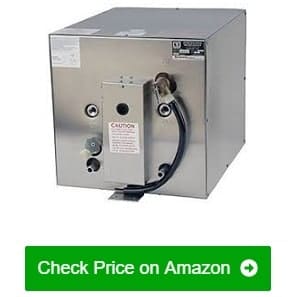
I bought this water heater to make sure that I always have hot water in my boat. Its 11-gallon capacity caught my attention among several other options in the market. It’s a product of the latest technology so it’s capable of bearing 1,500W.
It has a robust construction to withstand harsh marine environments and corrosion. So, I can rely on it in rendering the same performance through time. It simply means unrivaled durability. I can’t help but be astonished by its double-wall heat exchangers and integrated pressure relief valve. Both of these parts guarantee the security of water inside it and the preservation of heat.
Safety operation is also expected from this tank because of its protected ignition. The last thing that I want is to have a piece of equipment that acts up in my boat while sailing. Thankfully, this water heater gives me peace of mind. There’s a safety control to stop the build-up of unsafe temperatures as well.
- Has a large capacity to not run out of hot water
- Has a robust construction for durability
- With parts that keep and preserve hot water
- Safely operates with ignition protected and safety control
- Needs to be installed by two people as this is a large tank
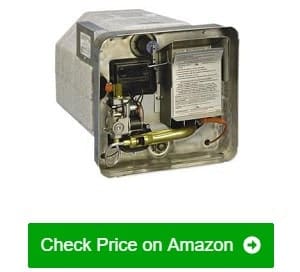
I don’t go for a tankless water heater if I want more pressure and very hot water. The things that I’m looking for are provided by a hardy tank like this one. Since I sail for a couple of days, it serves me well in providing hot water that I use for showers and washing dishes. This is also an RV marine water heater as it’s mostly used by those who permanently live in RVs.
I was able to double up my hot water supply from 6 to 12 gallons. This tank can be powered by propane and 120 volts of electricity. Although it’s big, I’ve noticed that it consumes less propane and it’s quieter too. Due to the adequate supply of hot water, there’s no interruption when taking a shower as long as the power source doesn’t cease to work.
Before mounting this heater, I flushed it first to ensure that the inside is clean. I did some minor adjustments to the plumbing and it didn’t trouble me at all. It doesn’t take much time and effort to complete the installation. After the assembly, give the cold tap water 15 minutes to turn hot.
- A hardy water heater tank
- With a capacity of 12 gallons which means doubling up your hot water supply
- Can be powered by propane or electricity
- Consumes less propane and operates quietly
- Easy installation to produce hot water in 15 minutes
- Not prone to leaks
- Some minor adjustments on plumbing
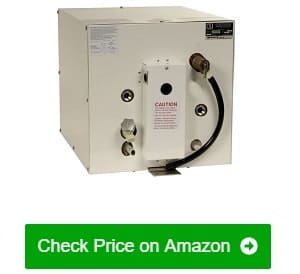
When I go sailing, I see to it that I dock my boat before sunset. But, I sometimes spend the night on the waters and return home the next day. Hence, this 6-gallon water heater is just right for my needs. It can be operated by 120 volt AC or engine coolant heat exchange.
To have constant availability of hot water, there’s a thermostat that regulates the heating temperature at 140 degrees Fahrenheit. You may also get cold water from it because of its 1/2-inch NPT.
The inner tank is made of aluminum while the exterior is of marine galvanized steel. With these premium materials, I know that this tank will be with me for a long time. Durability of a water heater is important for me so I have the assurance that it can take care of my boat’s water supply.
Set it up by horizontal mounting and hold-down brackets that are already attached to the inner tank. I did it with ease by myself. You will have to thoroughly check the fittings and heat exchanger parts to avoid any issue. Fortunately, it’s uncomplicated as they are all placed in the front of the tank.
- Can be run by electricity or a boat’s engine
- Has a thermostat that regulates water temperature
- Durable as it’s made of premium materials
- Easy mounting or installation
- With valves for safety operations
- Thorough checking of the fittings during installation
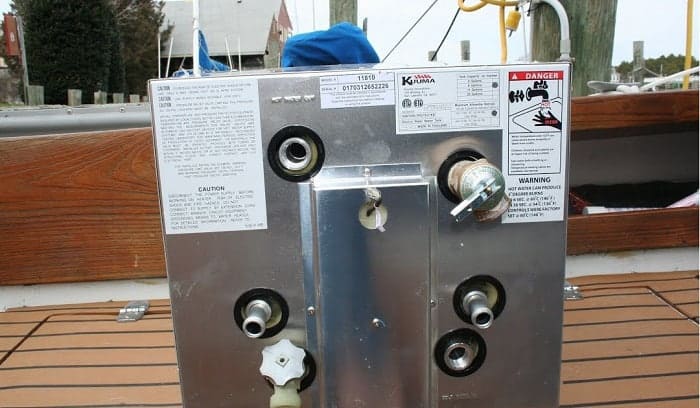
Before buying a water heater, there are two main things that you have to consider. Of course, the size of the heater should match your boat’s size so you have enough space for it. The next thing you have to think about is the number of people onboard. Hold your horses as you can’t just buy a 12V marine water heater if you have a lot of people cruising with you! There are other aspects that you have to ponder as well.
Propane or Electric Powered
Most of the water vessels these days have an electrical system. So, getting an electric-powered water heater is not troublesome. You should know that the heater will always be running without limitations if it’s run by electricity.
When it comes to a propane-powered heater, it has a quick recovery rate even when the temperature is low. You’ll also save on running costs. Some think that electric-powered ones tend to last longer. Nevertheless, propane-powered heaters can keep up.
On the brighter side, you’ll find exceptional water heaters that can be powered by both propane and electricity. So, at any time, you can switch to the power source that suits you best.
Water Heater Size
The water heater should be the right size for your boat. It shouldn’t be too big or too small. If you ignore this matter, it may be bulky for your boat or won’t provide the necessary amount of hot water. If you don’t have ample space for it, go for the tankless type as it’s compact.
Everything you put in your boat is exposed to the marine environment. In this matter, you should consider your boating routine and preference. Experts recommend stainless steel that can withstand all kinds of environmental and weather conditions.
A brand is appealing if it becomes popular due to the satisfaction that it gives buyers. So, settle for a company that has a good reputation and you won’t be disappointed with the quality of their products.
Marine Hot Water Heater Troubleshooting
Be concerned about troubleshooting as it’s important to get the heater fixed in case something goes wrong. Research the product to see if you can handle the necessary troubleshooting steps.
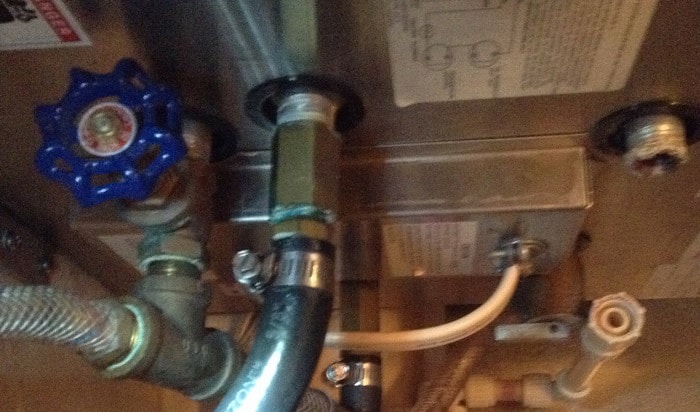
A marine water heater heats water that is used for cooking, washing, or shower. It seems like the one that is used at home but the operating system differs. Hoses are made as connectors instead of pipes .
There are two ways to heat a marine water heater. You can let it run by AC power or marine engine heat. This equipment only needs minimal power as any excess can disrupt ignition. It usually comes as a built-in but selections are in various sizes, patterns, and durability.
Companies become competitive these days. Thus, it’s not only the popular ones that excel in making quality products. Aside from the commonly known Superstor marine water heater and Isotemp water heater, Whale, Kuuma, Bosch, Ecosmart, and Suburban are trustworthy brands in terms of creating marine water heaters.
Most marine water heaters are easy to install. You can follow the steps in the instructional manual but in some instances, you may not need it at all.
You can mount it by the brackets and other hardware that come along with it. Then turn it on and you’ll have water in no time.
Rheem and AO Smith are known as makers of quality water heaters. The former also specializes in crafting air conditioning and air cooling systems while the latter only focuses on water heaters. AO Smith has better customer service than Rheem, which is the primary difference between them.
After reading this review, you know the importance and value of the best marine water heater. It’s an investment with a load of benefits. Hot water is a necessity but it can be luxurious when you’re cruising with your boat. It can make a huge difference in your sailing experience due to the immense comfort that it brings.

“I am James Harvey – founder of Boating Basics Online. It is established with the drive to help out first-time boaters, which are those desiring to explore their way through the water. So if you are new to boating, start from here with me. “
- New Sailboats
- Sailboats 21-30ft
- Sailboats 31-35ft
- Sailboats 36-40ft
- Sailboats Over 40ft
- Sailboats Under 21feet
- used_sailboats
- Apps and Computer Programs
- Communications
- Fishfinders
- Handheld Electronics
- Plotters MFDS Rradar
- Wind, Speed & Depth Instruments
- Anchoring Mooring
- Running Rigging
- Sails Canvas
- Standing Rigging
- Diesel Engines
- Off Grid Energy
- Cleaning Waxing
- DIY Projects
- Repair, Tools & Materials
- Spare Parts
- Tools & Gadgets
- Cabin Comfort
- Ventilation
- Footwear Apparel
- Foul Weather Gear
- Mailport & PS Advisor
- Inside Practical Sailor Blog
- Activate My Web Access
- Reset Password
- Customer Service

- Free Newsletter

Mason 33 Used Boat Review

Beneteau 311, Catalina 310 and Hunter 326 Used Boat Comparison

Maine Cat 41 Used Boat Review

Cheoy Lee Clipper 36 & 42 Used Boat Review

Tips From A First “Sail” on the ICW

Tillerpilot Tips and Safety Cautions

Best Crimpers and Strippers for Fixing Marine Electrical Connectors

Thinking Through a Solar Power Installation

Stopping Mainsheet Twist

Working with High-Tech Ropes
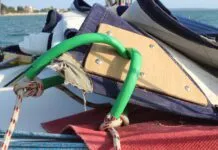
Getting a Clue for the Blown-Out Clew
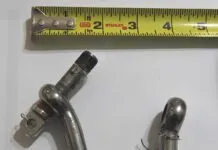
Monel Seizing Wire is Worth the Extra Cost

Fuel Lift Pump: Easy DIY Diesel Fuel System Diagnostic and Repair

Ensuring Safe Shorepower

Sinking? Check Your Stuffing Box

The Rain Catcher’s Guide

Boat Maintenance for the Technically Illiterate: Part 1

Whats the Best Way to Restore Clear Plastic Windows?

Mastering Precision Drilling: How to Use Drill Guides

Giving Bugs the Big Goodbye

Galley Gadgets for the Cruising Sailor

Those Extras you Don’t Need But Love to Have

UV Clothing: Is It Worth the Hype?

Preparing Yourself for Solo Sailing

How to Select Crew for a Passage or Delivery

Preparing A Boat to Sail Solo

On Watch: This 60-Year-Old Hinckley Pilot 35 is Also a Working…

On Watch: America’s Cup

On Watch: All Eyes on Europe Sail Racing

Dear Readers

Chafe Protection for Dock Lines
- Systems & Propulsion
Marine Water Heater Test
Ps reviews water heaters for 30- to 45-foot boats..
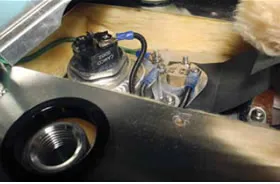
Water heaters are one of those silent heroes that rank high on the list of creature comforts on a cruising boat. Fortunately for us, boat builders long ago moved them from the options list to the standard features tally, and today, they are showing up on smaller and smaller cruising boats.
Ashore, residential water heaters are energy-hungry appliances, but on your boat, theres a convenient, symbiotic relationship between the heater and your diesel auxiliarys need to shed heat. In this case, circulating coolant in the engine is rerouted to the water heater, taking with it excess British thermal units (BTUs) caused by combustion. A heat exchanger inside the water heater then transfers some of this energy to the boats freshwater supply. Cruisers, particularly the stragglers working southward on the Intracoastal Waterway in November and December, appreciate this amicable exchange.
This win-win relationship works best when the right size water heater is chosen and the installation maximizes its reliability. In this in-depth look at water heaters, we focus on how they are made, how they work, and why some cost twice as much as others.
Users and do-it-yourself installers need to know a bit about heat transfer before they twist the tap. Most importantly, you need to be aware just how hot the domestic water supply gets when engine heat is supplied to the built-in heat exchanger. Many diesel cooling systems operate under slight pressure, and that raises the boiling point of the coolant, allowing the liquid to approach 200 degrees without fear of reaching the boiling point. When this heat-laden liquid is plumbed through the heat exchanger in a water heater, the temperature at the domestic water supplys hot faucets can exceed 140 degrees. This is hot enough to cause third-degree burns in only 6 seconds of contact.
If you find your water heater is too efficient when operating in the heat-exchanger mode, and temperatures are too high, you can add a mixer valve that blends cold and hot water as it leaves the water heater. It is important to note that the AC heating element is thermostatically controlled, so you don’t need to rely on a mixer valve when operating on shore power.
In port, its inconvenient and inefficient to run the engine solely to heat up water, and that is why most water-heater manufacturers put a secondary electric heating element in the boiler. These straight resistance devices use 110- or 220-volt AC current to electrically heat water in exactly the same way a household unit operates. Each manufacturer adds a layer of thermal insulation between the boiler tank and the outer shell. The colder the air and water temperature, the more important this insulation becomes. There are also gas-flame (usually propane) water heaters, with some safety concerns of their own, but in this round of testing, we focused on engine heat/AC current units.
What we tested
In our last water heater test ( PS , February 1999 ), Indel Marines all stainless-steel Isotemp 0221R was rated as the Best Choice. This is a well-made water heater, that is efficient and shaped to fit the bilge area aboard a wide range of sailboats. PS tester Frank Lanier has had one working flawlessly on his Union 36 cruising boat for five years now. The other standout in the 1999 test was Heat Transfer Products Marine Water Heater (previously called SuperStor Marine), which earned the Budget Buy. Nearly identical models from both of these manufacturers are still available today, and they retain our stamp of approval. Our testing in this round focused exclusively on new or significantly updated water heaters.
Three of the four test heaters derive heat from either recirculated engine coolant or from shore power when berthed in a marina. A generator could also be used to contribute either hot coolant or AC current to the water-warming process. These units also could be plumbed to a raw-water cooled engine, but be sure to consider the corrosive effects of hot salt water before going this route. Using raw-water circulation will surely shorten the lifespan of a water heater.
The main differences among the water heaters we tested were their construction materials and shape. We intentionally sought smaller 5- or 6-gallon models since these are most commonly found in sailboats from 30 to 45 feet. We added an 11-gallon unit to our testing, but kept it filled to the 6-gallon level when evaluating heat-holding efficiency.

Our test field included two units made in Italy, one from Thailand, and one from New Jersey. Kuuma, a subsidiary of the huge recreational-vehicle parts supplier Camco, sent us its 11-gallon tank. The company also sells a 6- gallon unit with the same 1,500-watt heating element.
Italy-based Quick Nautical Equipment sent testers one of its BX Nautique stainless-steel water heaters. These are efficiently designed, carefully fabricated units that can be mounted horizontally or vertically. Both the Sigmar Marine unit and the Quick water heater come with a handy combination check-valve/pressure-relief valve with a built-in drain lever.
Raritan has been building water heaters for decades, and the company has settled on its own approach to delivering a warm shower. The Raritan 1706 was the only unit we tested this go around that used a high-ferrous content boiler.
Sigmar Marine markets an Italian-made unit that comprises a stainless-steel boiler housed in a robust injection-molded plastic housing. The company uses a two-part, poured polyurethane foam in place of sheet insulation.
Desirable features
There is a lot to measure when it comes to heat-transfer experiments, and it would be easy to go overboard monitoring the extraneous. So, before setting up our evaluation procedure, we identified the desirable features of a good water heater for a cruising sailboat.
Useful attributes:
An ability to rapidly deliver and replenish hot water in both modes of operation.
Enough insulation to keep heated water hot for later usage.
Shaped to fit low in the bilge of a variety of sailboat designs.
Easily mounted, plumbed, and electrically connected.
Quality materials and construction.
Kuuma 11842
Both of the Kuuma units we tested feature a shiny stainless-steel outer shell surrounding an aluminum boiler with an aluminum heat exchanger. We saw no signs of corrosion during our short-term test, but we have some concerns about galvanic corrosion as the copper-based AC heating element, aluminum tank, and stainless-steel sheet metal interact over the long haul.
The manufacturer specifies that units equipped with a heat exchanger should not be used in a raw (salt) water cooling context. A ground fault interrupt (GFI) is recommended.
The box-shaped Kuuma 11-gallon heater used the same heating element as the 6-gallon unit, so by keeping the volume of water in the unit to 6 gallons during part of our testing, we mimicked the heating characteristics of the 6-gallon unit. It came as no surprise that this tank, with its 1,500-watt element, was the quickest to reach 120 degrees. The unit we tested was equipped with a rear-mount heat exchanger, and we found that this approach, plumbing the engine coolant loop away from other plumbing and wiring, could be an asset in certain tight installations.
The alloy heat exchanger was highly heat conductive; testers noted its quick warm-up times. Welded-in-place hose barb stubs on the heat exchanger simplified the plumbing hookups. Testers liked the handy nylon drain valve that lets you drain the tank with very little drama.
Bottom line: The price is certainly attractive, but with warranty exclusions for galvanic corrosion problems, longevity may be an important issue.
Quick Nautique BX2012
Quick uses highly corrosion-resistant 316L stainless steel in the Nautique BX2012s boiler, where it counts, and switches to a polished, grade 304 stainless steel for the outer shell, where corrosion conditions are not so hostile. The cylindrical shape of the unit is well-suited for bilge mounting in sailboats, and the stainless-steel mounting bracket and bands expedite a secure installation.
The small 20-liter (approximately 5 gallons) unit we tested is available with different heating elements (500, 600, and 1,200 watts), which significantly affect the time it takes to heat up cold water. The heating element is a nickel-based alloy (incoloy), and the stainless-steel heat exchanger features a large surface area that delivers good efficiency.
Unlike other heaters, the Quick showed no sign of ferrous metal parts. The Quicks shape makes it easier to mount the water heater as low in the bilge as possible. The directions recommend a double-pole switch on the heater element. It disconnects both the neutral and hot leads, a feature that lessens both shock and stray-current corrosion.
The unit we tested was equipped with the largest heating element offered for this size (1,200 watts), so comparing its thermal rate to that of heaters equipped with smaller elements was like comparing a big genoa with a small jib. Its heat-up speed came in just behind the 11-gallon Kuumas 1,500-watt element. Operating in the heat-exchanger mode, the Quick quickly transferred the engine-derived heat energy to the potable water supply. Because of this efficiency, a mixer valve would prove to be a valuable ally.
We liked the vertical or horizontal mounting options, plus the variable angle of the mounting base. As with the Sigmar unit, theres a need for metric thread adapters.
Bottom line: This compact, relatively easy to install, all stainless-steel water heater is a blend of artfully chosen materials and quality workmanship. It is our Best Choice.

Raritan 1706
Raritans units are made in the U.S. (the only in our test), so finding hose barbs or other plumbing fixtures to fit the National Pipe Thread (NPT) three-quarter-inch pipe thread ports wont be a problem. Because Raritan reduces the size of the plumbing at the ports to approximately a half-inch, the tank has a slower flow-rate than other tanks in the test. A pressure-relief valve is supplied, but a back-flow prevention check valve is not. Raritan provided, as usual, clear installation guidelines.
Raritan was the only test boiler made of high-ferrous-content steel. This SA 180 Grade 70 carbon steel meets American Society of Mechanical Engineers standards for forged carbon-steel pressure vessels, but it is inherently more prone to corrosion than the 316L stainless steel used in other heaters we tested. A hard porcelain enamel is thermally bonded to the inside of the tank, to provide a hard sanitary finish on the inside of the tank and protect against corrosion. According to the companys engineers, glass enameled tanks with anode protection will outlast other tanks in typical boat installation with galvanic and stray current problems.
In our view, an owner should first strive to fix stray current problems on the boat, as these can lead to serious corrosion problems in other systems. So long as the user follows maintenance and installation guidelines, galvanic corrosion is not a major worry on a well-made stainless boiler.
In addition, Raritan says its porcelain-enamel inner coating, plastic exterior cover, and enveloping insulation barrier of high-density, closed-cell foam protect the steel from chloride ions in the salt air. We noted that some portions of the tank are exposed to the air, and the outer insulation is not airtight. Raritan offers a five-year warranty on the boiler as long as the large manganese anode ($90 at West Marine) is checked annually and replaced as needed.
It came as no surprise that the drum-shaped Raritan water heater functioned well in both heat-exchanger mode and when operating under shore power simulation. The wiring, thermostat, overheat protection, and closed cell, high-density foam insulation were well done. There was a rugged feel to the three-quarter-inch NPT recessed plumbing seats, but we found that the half-inch plastic inserts in the hot and cold water inlet and outlet restricted flow.
Bottom line: Raritan has taken measures to build a non-stainless-steel tank that will resist corrosion better than thin-walled, mild-steel tanks that lack anodic protection; and the five-year warranty helps to instill confidence. If buying U.S.-made is a top priority, this tank fits the bill. However, in the absence of long-term test results, we prefer a high-quality stainless steel tank-particularly for saltwater boaters.
Sigmar BC30 UC08
Sigmar Marines compact stainless-steel boiler was clad in a heavy-duty plastic skin. The unit, like Quicks water heaters, is based on a stainless-steel boiler surrounded by poured-foam insulation, but in this case, the outer skin is a tough molded plastic. The 30-liter model (7.9 gallons) also used a 1,200-watt heating element. As might be expected, when the tank was full, it was a little slower to reach 120 degrees than the Quick unit. This was due to the fact that the Quick only had 5.3 gallons of water to heat.
The poured-in foam didnt release any odor when operating in the normal heat range (a possible concern at higher temps). This unit is designed to be installed lying on its side. The built-in heat exchanger, like the boiler, is fabricated from 316L stainless steel.
The male threaded pipe stubs welded to the boiler are metric, not NPT, so thread adapters or metric plumbing fittings are necessary. We also found the stainless-steel pressure-relief valve attached to the threaded stainless cold-water inlet needed some Teflon tape or pipe joint compound in order to stop a minor drip. Stainless-to-stainless threaded joints can gall and require care when tightening. Pipe tape or joint compound are a must. The use of a bronze metric-to-NPT thread adaptor solved the problem.
Plumbing connections and the pressure-relief valve/check valve were very similar to those on the Quick unit, and overall, construction quality was very good.
Bottom line: The efficiency of the Sigmars polyurethane foam surprised us, with over 80-degree water 20 hours after shutting off the heating element. It is Recommended.
All four of these water heaters use a 110- to 120-volt AC heating element when shore power or a good-sized generator happen to be available. Otherwise, they are happy with a supply of BTUs that stream directly from the auxiliary engines cooling system. There are a few plumbing challenges and wiring requirements, but an experienced do-it-yourselfer ready to follow manufacturer wiring and plumbing guidelines should have the skills and tools to install a water heater or replace a unit that has seen more than its fair share of sea miles.
We liked Raritans wiring and its all-NPT plumbing, but we had concerns about the high-ferrous-content steel boiler. Fiberglass and plastic liners did not cover all of the metal surfaces, and the reliance on a large sacrificial anode that can add to annual maintenance seemed a less than optimum marine material approach.
The aluminum boiler of the Kuuma unit we tested proved to be operationally sound, but many boatbuilders shy away from aluminum water tanks because the oxidation powder can foul drinking water, and in some cases, even cause poultice corrosion around welds. There are also some concerns about using bronze or stainless-steel plumbing fittings on an aluminum tank.
We liked the units with stainless-steel boilers and the overall construction quality of the Quick Nautique BX2012 SL and Sigmar Marines BC30 UC08 was very good. In the final tally, the Quick unit nosed out its Recommended Sigmar cousin, but the quality and performance ratings were quite similar. When all was said and done, testers liked the idea of a 316L boiler and found the polyurethane insulation very efficient.
These findings and the questions raised motivated us to plan Phase 2 of water heater testing, with a long-term test aimed at getting a close look at tank metallurgy and the effect it has on water-heater longevity.
- Construction Quality Draws Testers’ Attention

- Installing Water Heaters
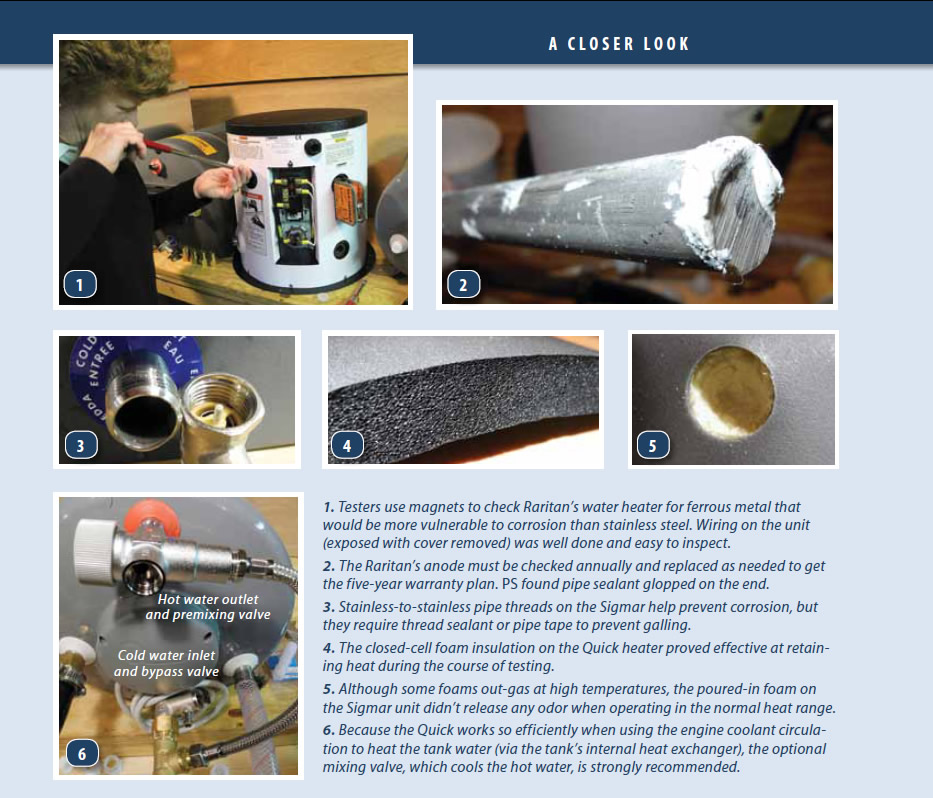
- Mix of Water, Amps, and Heat Calls for Caution
- Heat Transfer Products
RELATED ARTICLES MORE FROM AUTHOR
After reading this review, I know the importance and value of the marine water heater. It’s an investment with a load of benefits. Hot water is a necessity but it can be luxurious when I’m cruising with my boat. It can make a huge difference in my sailing experience due to the immense comfort that it brings.
Hi all, I have the Sigmar 30 liters installed and added the premixing valve. Only problem I have is when I use the shower the first water is boiling hot, only after 20 seconds or so the hot water and cold water mix and only then you can safely use the water. Is there a solution for this? (I have a pressure tank / bladder tank in my watersystem). Regards,……….Eric
LEAVE A REPLY Cancel reply
Log in to leave a comment
Latest Videos

The Perfect Family Sailboat! Hunter 27-2 – Boat Review

Pettit EZ-Poxy – How to Paint a Boat

The Boat From True Spirit – Sparkman & Stephens

Top 5 Boat Hacks – Boat Maintenance Tips and Tricks
Latest sailboat review.

- Privacy Policy
- Do Not Sell My Personal Information
- Online Account Activation
- Privacy Manager
- BOAT OF THE YEAR
- Newsletters
- Sailboat Reviews
- Boating Safety
- Sails and Rigging
- Maintenance
- Sailing Totem
- Sailor & Galley
- Living Aboard
- Destinations
- Gear & Electronics
- Charter Resources
- Ultimate Boat Giveaway

Don’t Land in Hot Water
- By Steve D' Antonio
- Updated: December 2, 2010
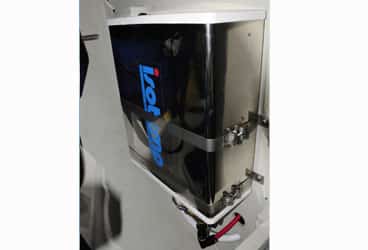
While it may look a lot like the one in your home, the marine water heater is a horse of a different color because many are designed to heat water in multiple ways, with varying results.
Nearly all water heaters will operate using either shore power or a generator. That is, AC current from either of these sources powers a heating element that’s immersed in the water, heating it to a temperature established by a thermostat. It’s important to note that electric water heaters are normally set to temperatures above 131 F to prevent the development of harmful bacteria, such as Legionella, the cause of Legionnaires’ disease, in the water supply. While many folks consider anything above about 105 F to be too hot, remember that hot water, when used, is often mixed with cold, so a higher setting will also mean that your hot water effectively lasts longer.
But most onboard water heaters can also operate by using heat from the engine while the boat is under way. The heat exchanger, much like the one that cools your engine or generator, simply transfers heat that’s generated elsewhere—in this case, in the engine’s closed cooling system—to the water inside the tank of the water heater. Instead of sending all of the excess heat created by the engine out with the exhaust, some of it is reclaimed for washing dishes, taking showers, and similar activities. What’s frequently not well understood by users is the fact that when the water is heated by the running engine, the electric thermostat exerts no control over the temperature of the water. This means that the water within the heater can be heated to the temperature of the engine’s coolant, creating a potentially dangerous scenario.
There’s only one way to control the temperature of water heated in this manner: by installing a tempering valve at the heater or anti-scald valves farther downstream, at the faucets. Tempering valves are easily added to virtually any water heater. The problem, though, is that many of them don’t react quickly enough to a surge of hot water to prevent scalding.
When a water heater is connected to an engine’s closed cooling system, certain protocols, as well as the engine manufacturer’s instructions, must be followed. Primary among these is the one governing the location, with regard to elevation, of the water heater. If the heat exchanger within the water heater or any portion of the plumbing between the engine and the water heater is located above the engine’s expansion-tank cap, then a remote expansion tank must be plumbed into the system. This tank, with its own pressure cap, then becomes the primary fill point for the closed cooling system, rendering the original legacy fill cap dormant and unusable. In most cases, when a remote expansion tank is installed, it must use the pressure cap called for by the engine manufacturer; the original cap located on the engine must then be replaced with a higher-rated cap; check with your engine manufacturer for specific instructions. This will ensure that the cap with the highest elevation in the system, the one that can vent air, is the only one that opens and closes with temperature-induced pressure changes.
Failing to install a remote expansion tank in the above-mentioned scenario could lead to air trapped within the cooling system, which in turn may lead to cold showers or, worse, an overheating engine.
Steve D’Antonio offers services for boat owners and buyers though Steve D’Antonio Marine Consulting .
- More: How To , plumbing , ship's systems , systems
- More How To

Rigging Redo: A Switch to Synthetic


Top Tools for Sailboat Cruising: Must-Have Gear for 2024

Made for Shade: Cockpit Cover Options

Blackwater Wisdom for Holding Tanks
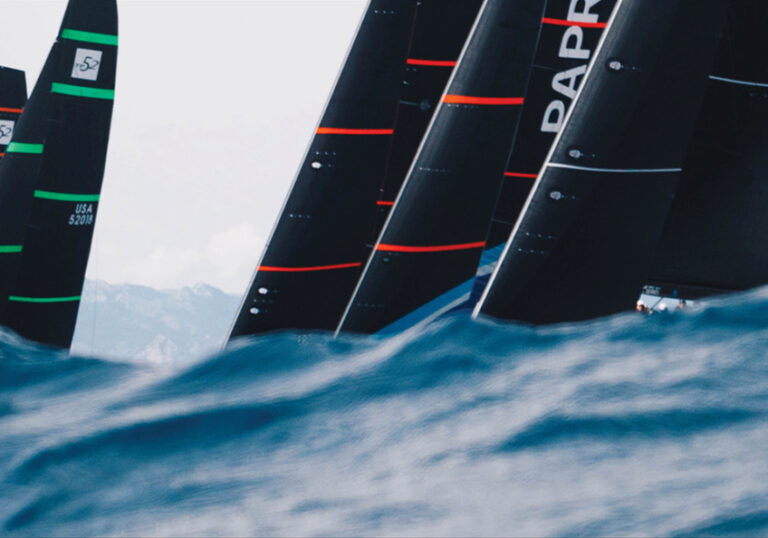
North Sails Parent Company Buys Doyle, Quantum
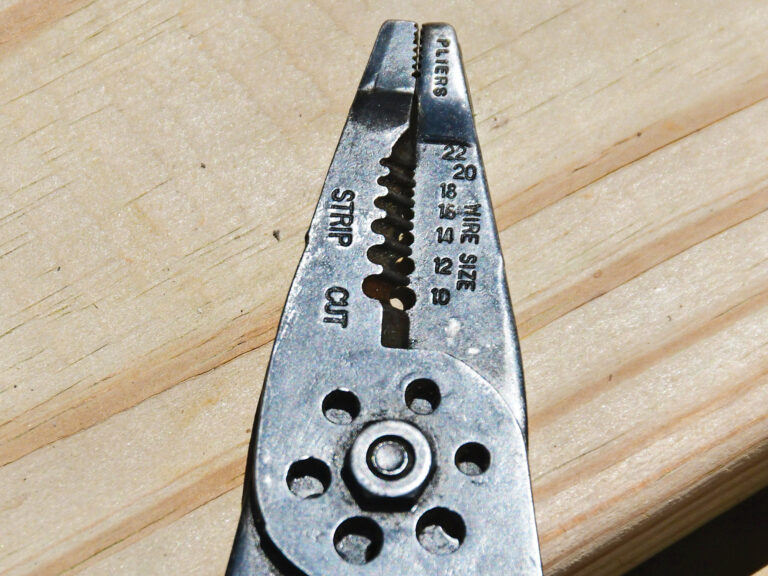
For Sale: 1984 Camper & Nicholsons 58
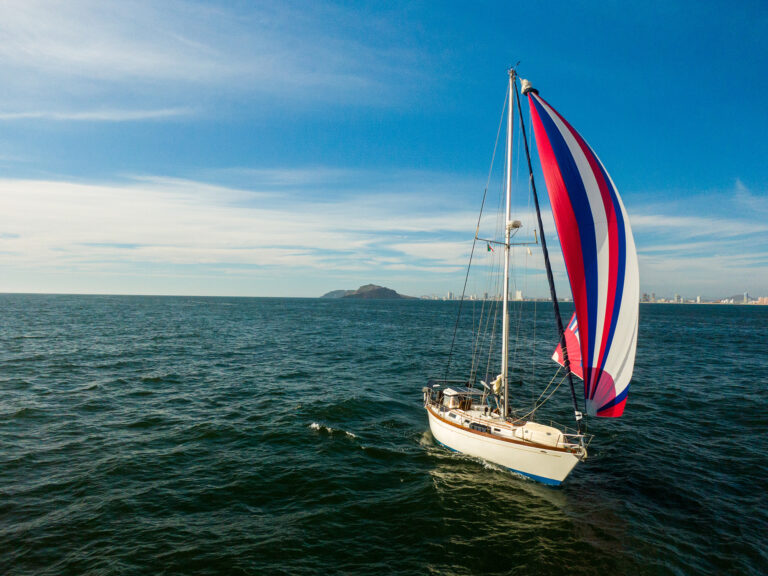
Sailing Avocet : A New Adventure Begins
- Digital Edition
- Customer Service
- Privacy Policy
- Terms of Use
- Email Newsletters
- Cruising World
- Sailing World
- Salt Water Sportsman
- Sport Fishing
- Wakeboarding

- Pumps & Sanitation
- Freshwater Systems
Marine Water Heaters

Kuuma 120V Front Mount 6 Gallon Water Heater #11811
Kuuma 120V Front Mount, Front Heat Exchange 6 Gallon Water Heater Ideal for galley use, this Kuuma 6-gallon marine water heater supplies enough hot water to wash clothing or dishes during a voyage or weekend trip. Thanks to a 1500W heating element and...

Camco Permanent Water Heater By-Pass Kit
Camco Permanent Water Heater By-Pass Kit Simple, permanent installation of the Camco Permanent Water Heater By-Pass Kit allows you to easily drain your water heater for winterizing. Comes with two brass valves, which provide non-restrictive flow...

Kuuma 120V 11 Gallon Water Heater - Front Mount, Front Heat Exchange
Kuuma Products 120V 11 Gallon Water Heater - Front Mount, Front Heat Exchange Marine water heaters are a convenient piece of equipment for boats that provide several conveniences from home. Boats are often used for a variety of different purposes and...

Camco Brass Water Heater Drain Valve 1/2"
Camco Brass Water Heater Drain Valve 1/2" Easily replace your water heater valve with a sturdy, easily-installed brass replacement valve. The Camco Brass Water Heater Drain Valve is constructed from premium 2010-compliant brass and creates a watertight...

Camco Quick-Turn Permanent Water Heater By-Pass Kit
Camco Quick-Turn Permanent Water Heater By-Pass Kit Simple, permanent installation of the Camco Permanent Water Heater By-Pass Kit allows you to easily drain your water heater for winterizing. Save on antifreeze when you winterize by using this...
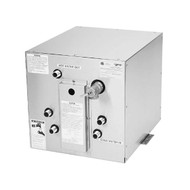
Kuuma 120V 6 Gallon Water Heater - Side Mount, Front Heat Exchange
Kuuma Products 6 Gallon Water Heater - Side Mount, Front Heat Exchange Product Features & Specs: Capacity: 6 GALLON Part Number: 11810 Dimensions: 15.625 in W x 13.625 in H x 19.375 in D Mount Arrangement: Side-Side Electrical Input: 120V -...

Camco Brass Blow-out Plug
Camco Brass Blow-out Plug Completely clear your water lines with the Camco Brass Blow-out Plug. Use this plug for winterizing to prevent your water lines from freezing. Using a blow-out pump to clear your water lines will help extend the life of your...

Kuuma 120V 11 Gallon Water Heater - Side Mount, Front Heat Exchange
Kuuma Products 120V 11 Gallon Water Heater - Side Mount, Front Heat Exchange Product Features and Specs: Capacity: 11 GALLON Part Number: 11840 Dimensions: 18.875 in W x 16.25 in H x 21.625 in D Mount Arrangement: Side-Side Electrical Input: 120V...

Camco Fresh Water System Dewinterizer
Camco Fresh Water System Dewinterizer For use with boats or RVs coming out of storage. Just one bottle freshens and deodorizes your Fresh Water System from tank to tap. Can be used for year-round freshening. Treats up to 60 gallons. Size: 16 oz.
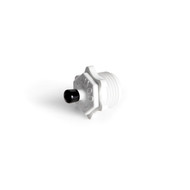
Camco Plastic Blow-out Plug
Camco Plastic Blow-out Plug Completely clear your water lines with the Camco Plastic Blow-out Plug. Use this plug for winterizing to prevent your water lines from freezing. Using a blow-out pump to clear your water lines will help extend the life of...

Kuuma 240V 11 Gallon Water Heater - Front Mount, Front Heat Exchange
Kuuma 240V 11 Gallon Water Heater - Front Mount, Front Heat Exchange Kuuma Premium Water Heaters are durable, compact, and efficient. Features include an aluminum tank and marine-grade aluminum alloy case for years of use. Kuuma's line of water heaters...

Johnson Pump CM30P7-1 Circulation Pump
Johnson Pump CM30P7-1 Circulation Pump The Johnson Pump CM30P7-1 is a heavy duty magnetically driven circulating pump. Compact but powerful, this is an ideal pump for circualtion duties such as water/antifreeze in heating systems or for circulating...

Johnson Pump CM30P7-1 Circulation Pump w/Cord

Kuuma 240V 6 Gallon Water Heater - Front Mount, Front Heat Exchange
Kuuma 240V 6 Gallon Water Heater - Front Mount, Front Heat Exchange Kuuma Premium Water Heaters are durable, compact, and efficient. Features include an aluminum tank and marine-grade aluminum alloy case for years of use. Kuuma's line of water heaters...

Raritan 20-Gallon Hot Water Heater w/Heat Exchanger - 120V
1700 Series Water Heater120v20 GallonWith Engine Heat ExchangerThe "1700 Series" water heater provides hot water for galley and shower. Dense foam insulation provides better and longer heat retention than traditional fiberglass. The tank itself is...

Johnson Pump CM10P7-1 Circulation Pump
Johnson Pump 10-24486-03 CM10P7-1 Circulation Pump The Johnson Pump CM10P7-1 is a heavy duty magnetically driven circulating pump. Compact but powerful, this is an ideal pump for circualtion duties such as water/antifreeze in heating systems or for...

Whale 120V 6 Gallon Galvanized Marine Water Heater w/Front Exchange
Whale 120V 6 Gallon Marine Water Heater with Front Heat Exchanger This Whale boat water heater is ignition protected and features a front heat exchanger. Constructed from marine galvanized steel for excellent corrosion resistance in marine environments...

Raritan 12-Gallon Hot Water Heater w/o Heat Exchanger - 120V
1700 Series Water Heater120v12 GallonW/O Engine Heat ExchangerThe "1700 Series" water heater provides hot water for galley and shower. Dense foam insulation provides better and longer heat retention than traditional fiberglass. The tank itself is...

Raritan 12-Gallon Hot Water Heater w/Heat Exchanger - 120V
1700 Series Water Heater120v12 GallonWith Engine Heat ExchangerThe "1700 Series" water heater provides hot water for galley and shower. Dense foam insulation provides better and longer heat retention than traditional fiberglass. The tank itself is...

Whale 120V 11 Gallon Galvanized Marine Water Heater w/Rear Exchange
Whale S1100 120V 11 Gallon Galvanized Marine Water Heater w/Rear Heat Exchanger This Whale boat water heater is ignition protected and features a rear heat exchanger. Constructed from marine galvanized steel for excellent corrosion resistance in marine...
When you need hot water while enjoying your boat, you can find a dependable marine water heater from Wholesale Marine. We stock a variety of heaters and replacement parts for leading manufacturers including Camco , Kuuma , and Raritan Engineering . Marine water heater capacities range from 3-gallons to 15.8-gallon tanks and are perfect for supplying hot water for showers, laundry, doing dishes, and other onboard tasks that require hot water on demand. You can rely on Wholesale Marine for quality marine water heaters, replacement, even maintenance components such as bypasses, de-winterizing solutions, drain valves, blow-out plugs, and anode rods-everything you’ll need to keep your marine water heater operating at peak function.
Marine Water Heaters Provide Hot Water on Demand
Need a marine water heater but are tight on space? Consider a Kuuma 120V Front Mount 6 Gallon Water Heater . While it may be small, you’ll find it offers the latest technology and has been manufactured with only the highest quality materials. Tough enough to withstand harsh marine conditions, this 6 gallon unit also conserves weight and footprint on board. If you're searching for a larger capacity marine water heater for showers and washing dishes, consider the Kuuma 120V 20 Gallon Water Heater - Vertical 4-Way Mount . Still compact but large-capacity, the aluminum tank maintains a constant temperature. Kuuma also offers marine water heaters in several capacities, including their uber popular 11-gallon model - a brand known for its reliability and long-life.
Wholesale Marine is well known for the best quality boat parts at competitive prices. This is why our happy customers return again and again. If you need assistance in selecting what part you’ll need, simply give us a call and enjoy our courteous and efficient service. We are boat enthusiasts too, and can help you make the right marine water heater selection. Be sure to ask about our Captain’s Club Rewards Program for additional discounts on everything you need to keep your boat in optimal condition for your next adventure! Call us at (877) 388-2628; we’re here Monday through Friday, from 8:30 AM until 4:30 PM, EST.
Subscribe to our Newsletter
Get the latest updates on new products and upcoming sales
Oops, something went wrong. Please try again.
You are now logged in!

- Forums New posts Unanswered threads Register Top Posts Email
- What's new New posts New Posts (legacy) Latest activity New media
- Media New media New comments
- Boat Info Downloads Weekly Quiz Topic FAQ 10000boatnames.com
- Classifieds Sell Your Boat Used Gear for Sale
- Parts General Marine Parts Hunter Beneteau Catalina MacGregor Oday
- Help Terms of Use Monday Mail Subscribe Monday Mail Unsubscribe

Hot Water using Engine Heat Exchanger
- Thread starter Dream Weaver #224
- Start date Jun 1, 2004
- Catalina Owner Forums
Dream Weaver #224
Does anyone know how long it takes running the engine to produce "Hot Water" via the heat exchanger to the hot water tank if its already cooled down to ambient?
Re: Hot water not sure of your hose routing. On my 34, I get no heating of the hot water until the thermostat opens, which I think is 160. My run down the channel to the dock takes about 20 minutes, always have hot water when we dock. Tank size will also effect the time. We have a 6 gallon hot water tank.
Chip Ehrlich
Hot Water All The Time Do you leave your hot water heater on all the time or do you just rely on the engine heat exhange?
DreamWeaver13428
Hot Water while on the hook 3rd day out. The 11 gallon water heater while on shorepower heats up fast and is hot for between 12-24 hours depending on use.While on the hook it seems to take quite a while to generate "hot" water via the exchanger (engine running).I am guessing 11 gallons is quite a bit to heat up via the exchanger at 160 degrees.
It takes a while to heat up while at anchor and just running the engine at idle or fast idle. If you are pushing the boat through seas and putting a load on the engine then it will get hot. But I have only been able to produce moderately warm water at anchor via the engine and I only have a 6 gallon water heater.
Pat McCartin
Hot water at anchor Your engine will only circulate hot coolant to the water heater when the thermostat is open. Think of the water heater like the heater on your car. If your having a hard time getting good heat at anchor, try putting the trans in reverse and pulling on the anchor with a higher idle. It's better to run the engine under load and will get to temp quicker.
Dreamweaver... What engine do you have. I just ran into the same problem with a Beneteau that has a Westerbeke. Is there any way you can post a photo of the front of your engine, the area where the hoses connect to the water heater? Pat
Common issue I just saw some friends at our marina...It seems at anchor there is never enough load on the engine to get the water past "warm".This was confirmed also on Beneteau's and Catalina's.
I disagree... My Perkins get the water to hot, 150'F. I believe there is an issue with the plumbing of the water heaters. Thats why I was asking. I'm taking the issue to Westerbeke tomorow.
DreanWeaver...please read and respond I've done some more research on the problem this weekend. If you have a Westerbeke,(painted red not light blue)do your hoses conect to a small tube between the circulation pump and the bottom of the thermostat housing? If so, then you have a circulation problem. The water in the hoses is getting warm by conduction and not flow. This keeps down the available BTU's to the water heater. Please respond to this post, I need more documentation to take the problem to Westerbeke and fight for a recall. Pat McCartin [email protected] Inland Marine Diesel Lake Lanier, GA 404-513-4414
Universal not Westerbeke..... I have the light blue color Universal Engine.It will produce hot water with the engine under load...but not at anchor or mooring.It usually gets warm enought for a shower using mostly hot water instead of the normal 50/50 mix of hot and cold.
Well, That news just throws a wrench in my plan. I found an issue with the Westerbeke. The Universal you have "should" be plumbed correctly. One hose goes to the circulation pump, the other to the thermostat area. The hoses should be 5/8" diameter. Think of a fresh water cooled engine like a car engine, it's thermostaticly controled to maintain a temperature. Idealy the engine should be 170-190 deg F. The water heater can be related to the heater on your car, same principal. Once the engine is at temp the coolant in the heater is active. The only reason I can think of for not generating heat is an air lock. Unless you have one of the new Force 10 heaters with scald guard. They are also thermostaticly controled to keep the temp of the hot water down. I don't know the specs.
Chris Burti
No Problem! I was always told that marine engines should not be idled for any length of time without being under load. I've never heard of this advice being debunked as a myth...so I follow it. When at anchor, I put the tranny into reverse and rev the engine up to about 1500 RPM. I do this to get the alternator to put out a decent charge. The secondary benefit is that as a result, there is plenty of hot water. We have a Cat 320 with the 3GM Yanmar.
- This site uses cookies to help personalise content, tailor your experience and to keep you logged in if you register. By continuing to use this site, you are consenting to our use of cookies. Accept Learn more…
Find Discounts on Your Favorite water Products and Save Up To 20%!

10 Best Boat Hot Water Heaters And Their Reviews For 2022
We may earn a commission if you click on a link, but at no extra cost to you. Read our disclosure policy for information.

So you have a boat, you might need a boat hot water heater for that.
You want to go sail out into the waters but are worried about having hot water to enable you to take a hot shower after a relaxing swim or to do some wash-up.
Just like in our homes, boat owners also feel the need to have hot water on their boats.
Hence will need to install a boat hot water heater unit to facilitate this.
IN A HURRY? HERE’S OUR FAVORITE PICKS…
| Preview | Product | Rating | Price | |
|---|---|---|---|---|
| No ratings yet | $631.03 $541.14 | |||
| No ratings yet | ||||
| No ratings yet | $460.99 |
Last update on 2023-12-15 / Affiliate links / Images from Amazon Product Advertising API
10 Best Boat Hot Water Heaters Reviewed
There are many water heaters in the market today, some of which have a modern touch while others are still in the bulky traditional designs.
In the boating industry, the water heaters used are usually either propane powered, use electricity, or make use of the waste from the engine to generate heat.
They are made from very high-quality corrosion-resistant material like aluminum steel or stainless steel, their unique design is to make them durable in any water conditions.
1. Whale Water Heater - Premium
The Whale Water Heater 120V is the ideal boat hot water heater.
It efficiently maintains an ample supply of hot water of up to 11 gallons.
With its double-walled heat exchanger system, the whale water heater utilizes the closed cooling system to heat water as the boat is running.
Also, while not in motion, the heater can be run electrically using a heating element that can be connected to the boat power supply or a generator.
To ensure its durability, the heater is made of sturdy materials that are resistant to corrosion.
You can choose a casing material of your choice for this heater, which can either be galvanized steel.
This is more substantial than most but has a longer lifespan; aluminum steel that is epoxy coated and blends well with the features of a boat or stainless steel, which gives it a modern look.
An additional feature to ensure durability is the anode that comes with the heater.
The whale water heater is especially useful for boats that sail in hard waters with high dissolved salt concentration or high currents.
The anodes help to elongate the life span of water tanks by corroding themselves instead of the containers.
They, therefore, need to be replaced as need be.
The heater is ‘ignition protected’.
This is a measure put in place to ensure safety when the heater is being used in the engine room.
It has a pressure relief valve and a drain valve that allow you to drain out water during the cleaning process.
Pros & Benefits:
- It is easy to install and quicker to heat water
- It can run off electric or heat power
- The heater comes with a two-year warranty
- It helps to prolong the lifespan of the water tanks by preventing corrosion
Check Price and Reviews on Amazon
2. American Standard Electric Water Heater
Second, on the list is the American Standard, a well-renowned water heater brand.
This brand seems to be a favorite among many boat owners.
This is a high-quality brand of water heater that is made to last long.
The heater can operate on gas or electricity.
The American Standard brand offers a wide range of models, each with different capacities to suit different needs.
The interior of the tanks on this heater is made from durable steel—couples with a fiberglass filler, and anodes that protect the tank from corrosion.
The anodes, however, have to be replaced as seen fit since they corrode with time.
Maintenance of the American Standard heater tank is easy since it has a hand hole allowance that allows for cleanup inside the container to remove the residues that build up with time.
The American Standard Water Heater is ideal for boat owners looking to heat a large volume of water on demand.
It has a large storage water capacity of up to 119 gallons of water with a heating element of up to 54Kw.
When it comes to warranty, the American Standard Water Heater is unbeatable.
The heater comes with a warranty of six years, while models with tanks lined with glass have a guarantee of twelve years, the same as the estimated lifespan of the heater.
- It helps to reduce the cost of energy by its ability to retain heat for longer periods
- Has an adjustable thermostat that enables you to regulate the temperature of the water as you feel fit
- The American Standard Water Heater comes with a preset temperature and pressure relief valve
- It is an easy to install point-of-use electric water heater: no long waits for the water to heat up
- The American Standard Water Heater has a superior thermal efficiency
3. Kuuma Water Heater
Kuuma Water Heaters have an excellent reputation among popular boat manufacturers in the industry.
This is a dual powered water heater meaning it can be powered either by electricity or by using engine power.
Therefore, the water heater can be used whether the boat is on the sea or at the docks.
The heater’s casing is made from high-quality aluminum that makes it resistant to corrosion.
Also, the casing makes it excellent at retaining heat.
The Kuuma Water Heater has 11 gallons, which makes it the best for boats that have high hot water requirements.
However, it also has models that have a small hot water capacity of 5 or 6 gallons or a large capacity of 20-26 gallons.
To ensure safety when in use, the heater comes with an ‘ignition protect’.
This is to prevent any hazardous occurrences when in use in the engine compartment.
- Kuuma Water Heaters are easy to install and maintain
- The heater comes with a two-year warranty on the heater
- It is highly effective when using either electricity or engine power
- The heater comes with hose barbs and pipes for domestic water
4. Bosch Tronic 3000 Water Heater
The Bosch Tronic 3000 is an electric mini-tank that is portable hence making it an excellent option for the outdoors as in a boat.
With its compact design and small size, the heater becomes easy to install by directly mounting it on a wall, under a sink or in a cabinet.
Bosch Tronicmodels come in different water capacities.
It is a cost-effective alternative since it operates without a tank.
The water capacity of these heaters could range anywhere from 2.5 to 7 gallons.
However, since the heater is small, you can only get enough hot water for one chore at a time.
The Bosch Tronic 3000 has a recovery rate of 6.8 GPH at about 90 F.
This rate varies depending on how cold the incoming water is.
The water pressure range is about 150 psi.
Although the heater is small, it has been equipped with features superior to other big models.
The Bosch Tronic 3000 is lined with glass that prevents it from corrosion over a long period of use.
The best feature of this model is that it is capable of supplying water to multiple sources simultaneously.
It’s also a good option if you are looking to conserve energy since it comes with a CFC- free form insolation.
It also comes with temperature control to enable you to adjust the water temperature to your liking.
The only downside of this heater is that it needs to be installed close to the hot water outlet.
- The heater comes with a two-year warranty on its parts and a six-year warranty on the tank
- Long lifespan: the tank is lined with glass making it corrosion resistant
- It has a fast recovery rate; hence no long waits between drawing water
- It is a point of use water heater which is fast and reliable: you get hot water as soon as you open the tap
- With this heater, warm water delays or cut out is at minimal
5. Atwood 94023 Water Heater
Atwood water heaters are electric heating units that are highly reliable.
It’s lightweight, therefore makes it easy to install and to service.
This heater is made for an aluminum alloy that makes the storage tank resistant to corrosion hence elongates its life span.
It’s a great feature, especially for boats that sail in harsh weather conditions.
For the Atwood 94023, the hot water capacity is at 10 gallons with a heating element of 1400Kw and operating on 120V.
To ensure that the freshwater is not contaminated, this heater is made using the double tube technique.
To heat the water, the heater uses a hot water coolant.
This is not a point-of-use heater; therefore, you will need to give the heater time to heat the water.
It is, therefore, essential to ensure that the connection between the engine and the water heater is made correctly to prevent damage to the engine.
- Due to its small size, this heater is ideal where there is minimal floor space
- It comes equipped with a factory set thermostat and with a temperature and pressure valve
- Keeps the water warm for a more extended period
- Atwood heaters are effective and resourceful
- The heater is compatible with most motors hence little to no adjustments are needed
- Atwood heaters have multiple safety protections such as temperature-pressure relief valve, thermostats, and a limit switch
6. Stiebel Eltron Tempra 24 Plus
This is yet another small electric heater that has no tank and is great for the outdoors.
This heater can be plugged in on a wall outlet, making it quite flexible and portable.
Its sleek design ensures that the heater can fit in places with minimal available space.
This heater has a flow rate of up to 4.68 gallons per minute, making it a higher performer than some gas heaters.
Since it doesn’t come with a tank, this water heater is considered the best in saving energy.
This is because water is only heated as required.
The Tempra 24 plus comes with a temperature control allowing you to adjust the water temperature to your liking.
A significant advantage of this heater is that two fixtures can use it at the same time.
One of its useful features is a thermostat that allows you to regulate water temperature as you use it.
Likewise, this heater comes with a high-tech flow control system.
This allows the regulation of water to be able to keep up with the demand.
When installed with a qualified technician, the product comes with a seven-year warranty.
- No venting is required
- The heater is small hence making it easy to install and maintain
- Temperature changes are easy to adjust
- Big on energy saving since it uses minimal energy
- Ensures an unlimited supply of hot water
- Since it has no tank, this water heater helps to save on space
7. Water Heater Propane, Camplux Outdoor Portable Camping Gas Tankless Hot Water Heaters, 2.11 GPM,...
This is the perfect water heater for the outdoors with a 10-liter capacity and a 2.64 gallons per minute model.
It comes packaged with a showerhead, a gas regulator, and the required adapters.
Camplux Heater is small, compact, and lightweight making it easy to be positioned anywhere.
The heater is hooked to a propane cylinder powered by D-cell batteries making it the best choice for off-grid locations.
Despite its small size, the heater’s maximum power output is about 68,000 BTUs.
It also has a stainless steel burner and a copper heat exchanger that generates thermal energy efficiently.
Camplux has an energy control point that allows you to save energy when the weather is reasonably warm.
It also has an automatic shut-off switch that automatically switches the heater off when the temperature exceeds the safe levels.
On the contrary, its anti-freezing technology helps to drain out residue water through the drain plug during cold days.
- Its thermal efficiency is very top-notch
- Can work effectively without mains electricity
- Comes with a showerhead and adapters on purchase
- Has a 20-minute automatic safety device
8. Isotemp Water Heaters
On this list, this is probably the most expensive choice, but it is worth it.
The Isotemp Water Heaters are more traditional, a bit heavier, and bulkier than the modern heaters.
It is the best choice if dealing with harsh water conditions.
These heaters are lined with a eutectic solution that enables water to remain warm for a more extended period.
Isotemp water heater is known to heat water to a temperature of up to 145F in an hour.
The unit can either be mounted horizontally or vertically and banded by two steadies, one on each side to help support.
This makes it robust when installed.
Additionally, the heater is made from stainless steel, which protects it from corrosion through hard water or harsh weather conditions.
The stainless steel casing is used for both the tubes and tanks, as well as any other part that might come into contact with water.
The Isotemp water heaters come in different sizes with a water storage capacity ranging from 4 to 6 gallons.
It has an immersion heating element of about 750W to 1000W and uses heat from the engine’s coolant to heat the water.
- All models come with a five-year warranty
- The polyurethane insulation helps preserves water temperature for long (up to 24 hours) hence the best when you want to use water without having to reheat
- Comes with a safety relief valve
- The water inlets and outlets in this product are carefully designed to minimize the mixture of hot and cold water
No products found.
The Raritan Water Heaters another famous brand in the boat water heater manufacturing industry.
These heaters are specifically designed for water machines.
At the price it comes in, this product works reasonably well.
Unlike the older model, the new and improved model of the tank is glass-lined with steel.
It, however, needs the support of anodes to prevent corrosion to the tank.
Raritan Water Heater fittings are galvanized while its tank is lined with a black foam sheet on the outside.
It comes with an adjustable thermostat that enables you to regulate the water temperature as you feel fit.
The heater has ignition and thermal overload protection to prevent any hazardous occurrences from happening.
It has a heating element of 120V with a water storage capacity of 20 gallons.
- The heater is quick at heating water
- The heater comes with a five-year warranty
- Raritan Water Heaters are environmental-friendly; they have a CFC-free foam insulation
- All models come with a five-year warranty on the tank and a two-year warranty on the heater
- It is simple to install and has a design that makes it compatible with many pressure systems
10. Whale Seaward Water Heater
The seaward heaters are made with stainless steel in several parts that are carefully joined together.
The plumbing pipes are galvanized while the tank is insulated with fiberglass, which protects it from corrosion.
This heater has a switch used to switch off the heater once the water temperature gets high.
It operates on a 12OV heat exchanger.
The Whale Seaward Water Heater uses a combination of both electric and heat exchangers to heat the water.
The seaward water heater has a water storage capacity of up to 11 gallons.
For safety, the heater has an ‘ignition protection’ to prevent any hazardous occurrences from happening when the engine is running.
- This water heater has a large drain valve to drain residue during cold days
- It has brackets welded on the tank to make it sturdy when mounted
- This water heater comes with a temperature relief valve
What To Consider When Choosing a Water Heater
Shopping for a water heater can be quite confusing and overwhelming.
There are many different types of brands and models available in the market, each with different specifications, build, capacity, and power.
A water heater can either make or break your boat ride experience.
A few things to keep in mind when planning to install or upgrade your water heater include:
With all the above considerations.
Choose a heater that fits your needs and is within your budget.
Although, it is best to note that with water heaters, the lowest cost is rarely the best value.
This is important as it helps to ensure the product works as intended.
The higher the warranty duration, the better.
How much available space you have on your boat to install the heater.
If working with little space, you might want to purchase a heater with no tank.
Heaters that use less energy are better since the energy supply on a boat is usually limited.
Water heaters can be quite hazardous if not correctly installed, especially when the engine is running.
It could result in a fire.
If not sure, ask a professional to install the heater for you.
Depending on the number of people, you anticipate being having on board regularly.
Choose a heater that can hold as much water as required.
Some heaters are best suited for commercial use, while others are made for small scale use.
Whether the boat is used for commercial use or personal use will determine the type of heater to purchase.
As much as most are highly durable.
You might choose to buy one made from stainless steel rather than one made from aluminum.
This is dependent on several factors, such as the type of water you sail on.
The prevalent weather condition in your region.
Final Thoughts
Nobody likes taking a cold shower.
Especially not on a cold day when you are out in the waters.
Therefore, having a boat hot water heater provides you with a different onboard experience, especially during the cold season.
Whether you are doing the installation by yourself or having a professional fix it for you, the process is quite easy.
A hot water heater installation ensures the storage and redistribution of freshwater within the system of the vessels.
Related Posts

10 Best Heat Pump Water Heaters And Their Reviews (2023)
Today there are many best heat pump water heater models. Some are more efficient and it’s sometimes difficult to make…

Can You Lay a Water Heater On Its Side? (Dos and Don’ts, FAQs, and more)
One of the questions we often get asked is whether or not you can lay a water heater on its…

How Do I Put Hydrogen Peroxide In My Hot Water Heater? (And Why To Do It)
If you’re looking for a way to clean your water heater or want to prevent rust and corrosion, you may…
In a Hurry?
Take a look at the most popular and trending water products.
© Copyright 2021 Thewaternerd.com. All rights reserved.
The information on this website should not be take as a substitute for professional advice. Thewaternerd.com may be compensated when users click on links and sign-up with their associated offers located in content or anywhere else on the page. View our privacy policy and our disclosure policy for more information. Thewaternerd.com is a participant in the Amazon Services LLC Associates Program, an affiliate advertising program designed to provide a means for sites to earn advertising fees by advertising and linking to Amazon.com.
Theme version 1.78.
- Types of Sailboats
- Parts of a Sailboat
- Cruising Boats
- Small Sailboats
- Design Basics
- Sailboats under 30'
- Sailboats 30'-35
- Sailboats 35'-40'
- Sailboats 40'-45'
- Sailboats 45'-50'
- Sailboats 50'-55'
- Sailboats over 55'
- Masts & Spars
- Knots, Bends & Hitches
- The 12v Energy Equation
- Electronics & Instrumentation
- Build Your Own Boat
- Buying a Used Boat
- Choosing Accessories
- Living on a Boat
- Cruising Offshore
- Sailing in the Caribbean
- Anchoring Skills
- Sailing Authors & Their Writings
- Mary's Journal
- Nautical Terms
- Cruising Sailboats for Sale
- List your Boat for Sale Here!
- Used Sailing Equipment for Sale
- Sell Your Unwanted Gear
- Sailing eBooks: Download them here!
- Your Sailboats
- Your Sailing Stories
- Your Fishing Stories
- Advertising
- What's New?
- Chartering a Sailboat
- Boat Water Heater
Get Free Hot Water from a Boat Water Heater
A boat water heater can usually be retro-fitted without too much difficulty, as long as your boat has a freshwater cooled engine. This type of marine engine, unlike a raw seawater cooled engine, has a separate closed system with its own header tank, which is then cooled by a freshwater/seawater heat exchanger.
The other requirement is for a pressurised domestic water system. A manually pumped system, laudable though it is, just won't do - but it's usually a straight forward affair to convert it to a pressurised system.
On a boat thus equipped, you can get that rare commodity; something for nothing - and you should take advantage of it.
Any boat that uses its engine fairly regularly produces hot water as a by-product of the combustion process, and it's free. Once you've shelled out for the equipment that is - which in this case is a boat water heater known as a marine calorifier.
This device is effectively an insulated heat exchanger, which plumbed into the engine cooling water system will transfer heat from the engine into the domestic water supply.
A typical hot and cold domestic water installation is shown in the illustration below.
How a Boat Water Heater System Works
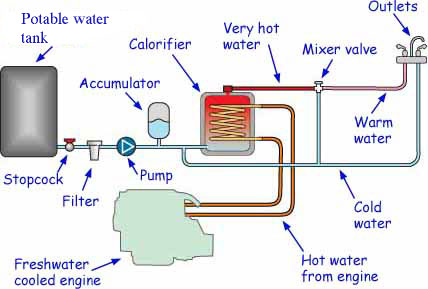
Artwork by Andrew Simpson
This system incorporates both a pump and an accumulator. Most water pressure pumps maintain steady pressure by cycling on and off, producing a pulsed delivery.
The accumulator tank, containing water and air - usually but not always separated by a diaphragm - absorbs this pulsation and provides steady flow. Some pump manufacturers now produce microprocessor-controlled variable-speed pumps which eliminate cycling and make the accumulator tank redundant.
The mixer valve operates thermostatically, introducing a metered amount of cold water into the outlet flow, thus maintaining regulated temperature and conserving hot water.
The pipework from the engine should be as short as possible to minimise heat loss, and should be installed lower than the level of the engines header tank.
Calorifiers are well insulated and will continue to provide warm water for an hour or two after the engine has been turned off, but if you haven't run the engine for a much longer period, turning on the hot tap won't produce the desired result.
Immersion-Type Water Heaters
Electric immersion heaters, much like the larger versions we're accustomed to at home, require AC power, so unless you've got a generator aboard their use is restricted to when you're alongside and hooked-up to an onshore supply.
Immersion heaters are often combined with a calorifier in a single unit.
The stainless steel Isotherm units shown here are the immersion/calorifier type and are equipped with a thermostat.
In immersion heater mode, they draw around 6.5A at 120V.
Hot Water from the Sun!
Intended for campers, but perfect for sailors cruising in warm, sunny climes.
Cheap and effective - every cruising sailor should have a couple of these on board!
Gas Water Heaters
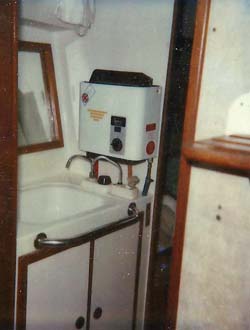
Bulkhead mounted gas water heaters like the one shown here are no longer popular on sailboats, many skippers believing that they're just too plain dangerous.
If you do decide to invest in one of these however, make absolutely sure that it has an automatic low gas pressure cut-off switch and a flame failure device fitted, and it's properly serviced and regularly maintained.
I used to have one on a previous boat - this one in fact, on my Nicholson 32 'Jalingo' and lived to tell the tale.
But would I have another? No, definitely not.
In fact I'm not even going to tempt you with an example.
My advice? Don't touch them, and if you've got one — get rid of it!
Other Plumbed-In Systems you may want to take a look at...

Which Type of Boat Fridge Is The Most Efficient?
The top opening boat fridge is reputed to be more efficient than the front opening type, but that may not be the case - and here, amongst other boat refrigeration considerations, is why

Not All Gas Boat Cookers Are Safe For Use At Sea
Good quality gas boat cookers go a long way towards protecting the cook from the very real risks of cooking at sea. Here are the essential safety features you should look for

Which Boat Galley Layout Is Best for Offshore Sailing?
A properly thought-out boat galley is a key component of an offshore cruising boat. So where should it be located, and what's the best arrangement for the individual galley components?
Recent Articles
Island Packet 37 Specs
Aug 23, 24 03:17 PM
Jeanneau Sun Odyssey 40 Specs
Aug 23, 24 04:18 AM
Jeanneau Sun Odyssey 409 Specs
Aug 22, 24 11:02 AM
Here's where to:
- Find Used Sailboats for Sale...
- Find Used Sailing Gear for Sale...
- List your Sailboat for Sale...
- List your Used Sailing Gear...
Our eBooks...

A few of our Most Popular Pages...

Copyright © 2024 Dick McClary Sailboat-Cruising.com

Please verify you are a human
Access to this page has been denied because we believe you are using automation tools to browse the website.
This may happen as a result of the following:
- Javascript is disabled or blocked by an extension (ad blockers for example)
- Your browser does not support cookies
Please make sure that Javascript and cookies are enabled on your browser and that you are not blocking them from loading.
Reference ID: 5d12d4ed-61d3-11ef-8233-65dff49ec987
Powered by PerimeterX , Inc.

IMAGES
COMMENTS
4317A S Sheridan Rd , Tulsa OK 74145-1120. home. categories. plumbing & ventilation. marine plumbing. freshwater systems. water heaters. Bring the comforts of home on board with a marine water heater. Having on-demand hot water to wash dishes in the galley, take a shower or warm up wetsuits is a huge step up in making your time on board more ...
The physical installation of a water heater in your boat may seem pretty straightforward, but the devil is indeed in the details. ... For domestic hot water the same fluid goes through a flat-plate liquid to liquid heat exchanger. I have a similar hot water loop that I recirculate shower water so I can take my usual 20 minute hot shower using ...
Electric water heaters are ideal for boats with a stable electrical supply. Engine-Connected Heaters. Engine-connected marine water heaters use the heat generated by the boat's engine to heat the water. These heaters often feature a double-walled heat exchanger system that transfers heat from the engine's cooling system to the water tank.
This sailboat water heater is reliable in delivering hot water. It warms water in just a few minutes so you won't have to wait too long. 2. Kuuma 11G 120V Front Exchanger. Due to this quick marine water heater, the supply of hot water in my boat doubled. It's lightweight with fiberglass sheets for insulation.
Water Heater 20 Gal. - Front Heat Exchanger - Stainless - Vertical. SKU: 50126 | Item ID: S/W S1900. $1,284.27. Out of Stock. Raritan Anodes for 1700 Series Water Heaters. ... When selecting a boat hot water heater, consider factors such as: Boat size and hot water demand. Available power sources (engine heat, shore power, or both).
Enjoy hot water heated dockside with 120V AC power or with engine heat when underway. West Marine water heaters feature a marine-grade aluminum case and cladded aluminum tank. A 1500W heating element and large diameter, dual-loop heat exchanger provide two ways to heat water. Circuitry is ignition protected for use on gasoline powered boats.
Whale Seaward 11 Gallon Hot Water Heater W/Rear Heat Exchanger - Stainless Steel - 120v - 1500w. Rating: (4) $610.38. Add to Cart. Whale Seaward 6 Gallon Hot Water Heater W/Front Heat Exchanger - Galvanized Steel - 120v - 1500w. Rating: (9) $459.46.
Easy installation and maintenance. Energy-efficient operation. Durable and long-lasting construction. Customizable sizing and heating options. Browse our complete selection of Isotherm products. Can't find what you're looking for? Let us help. 206-632-4462. Enjoy hot showers on the go with Isotherm marine water heaters!
Shop Water Heaters for boats, yachts, marine fixtures and more at Defender. Get fast delivery and free shipping on eligible orders over $99. ... Seaward Marine Water Heater with Rear Heat Exchanger $539.99 - $572.99. 0. ... Seaward Hot Water Heater for Outboard Boats - 3 Gal - S360EW $733.99. 0. Isotemp Basic 40 TCT Dual Coil Marine Water ...
12V WATER HEATER. Part no: S360EW. Hot water on-the-go for outboard boats. No generator / inverter / shore power required. Rapid heat up provides hot water in less than 1 hour*. Ideal for use with deck showers - perfect for warming wetsuits. Safety features include low current switching, integrated temperature and pressure valve, thermal cut ...
In our last water heater test (PS, February 1999), Indel Marines all stainless-steel Isotemp 0221R was rated as the Best Choice. This is a well-made water heater, that is efficient and shaped to fit the bilge area aboard a wide range of sailboats. PS tester Frank Lanier has had one working flawlessly on his Union 36 cruising boat for five years ...
Because the water heater on your boat has two sources of heat, you need to understand the differences in temperature that are possible to avoid a scalding. "Hands-On Sailor" from our December 2010 issue. If you install or replace a water heater, use high-quality hose to avoid any chance it could rupture. SAE J2006-rated hose works well.
11811 - 6 Gallon Water Heater - 120V. Kuuma's Premium 6 Gallon Water Heater is perfect for a new installation or as a replacement to an existing water heater. Constructed of corrosion-resistant, marine-quality aluminum and heats water with the use of an electrical power or integrated heat exchanger. Features: Technical Specifications: *Sold as ...
Marine Water Heaters. When you need hot water while enjoying your boat, you can find a dependable marine water heater from Wholesale Marine. We stock a variety of heaters and replacement parts for leading manufacturers including Camco, Kuuma, and Raritan Engineering.Marine water heater capacities range from 3-gallons to 15.8-gallon tanks and are perfect for supplying hot water for showers ...
Hot Water while on the hook 3rd day out. The 11 gallon water heater while on shorepower heats up fast and is hot for between 12-24 hours depending on use.While on the hook it seems to take quite a while to generate "hot" water via the exchanger (engine running).I am guessing 11 gallons is quite a bit to heat up via the exchanger at 160 degrees. T.
Enjoy hot water on your boat with a dependable Seaward Marine Water Heater. Heat water dockside with 120V AC power or when underway, using engine heat. This water heater features an ignition-protected design, cladded aluminum tank, dual-wall heat exchanger and stainless steel case. Heat exchanger ports are located at the "Rear", opposite the ...
Models are offered with or without a built-in engine water heat exchanger and choice of a 120V or 220V AC heating element. For installation and maintenance, see the 1700-Series Water Heater Instructions. Key Features. Solid-foam insulation keeps water hot longer than traditional fiberglass insulation; Specifically designed for the marine ...
1. Whale Water Heater - Premium. The Whale Water Heater 120V is the ideal boat hot water heater. It efficiently maintains an ample supply of hot water of up to 11 gallons. With its double-walled heat exchanger system, the whale water heater utilizes the closed cooling system to heat water as the boat is running.
Any boat that uses its engine fairly regularly produces hot water as a by-product of the combustion process, and it's free. Once you've shelled out for the equipment that is - which in this case is a boat water heater known as a marine calorifier. This device is effectively an insulated heat exchanger, which plumbed into the engine cooling ...
Shop KUUMA 11 Gallon Front Mount Water Heater with Rear Heat Exchanger, 120V at West Marine. Visit for prices, reviews, deals and more! ... Installed as original equipment on many boats, including Sea Ray, Four Winns, Hunter, Beneteau, and Boston Whaler, Kuuma water heaters enable you to enjoy hot water heated dockside with AC power or with ...
Enjoy hot water heated dockside with 120V AC power or with engine heat when underway. West Marine water heaters feature a marine-grade aluminum case and cladded aluminum tank. A 1500W heating element and large diameter, dual-loop heat exchanger provide two ways to heat water. Circuitry is ignition protected for use on gasoline powered boats.
Shop the best selection of SEAWARD Water Heaters from West Marine. Visit for products, prices, deals and more! ... Boats & Motors. Boats. Inflatable Boats. Inflatable Boat Parts & Accessories; ... 6 Gallon Water Heater with Epoxy-Coated Aluminum Case and Front-Mounted Heat Exchanger, 120V AC 20-Gallon Water Heater with Epoxy-Coated Aluminum ...